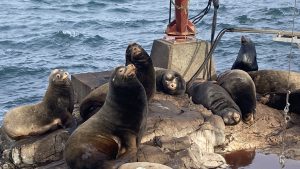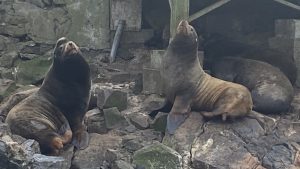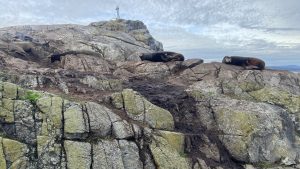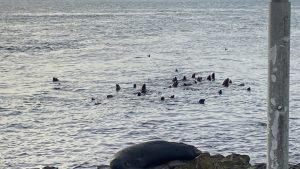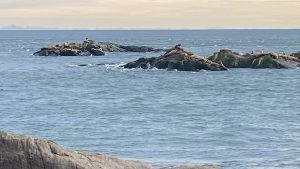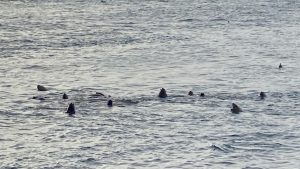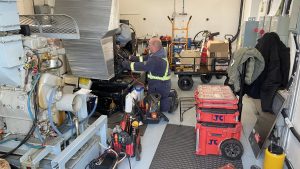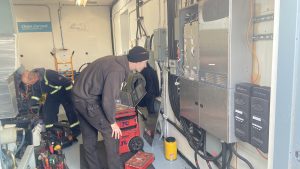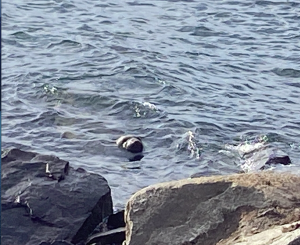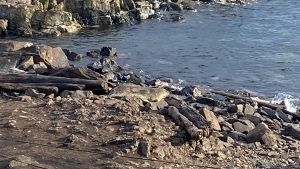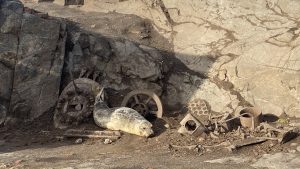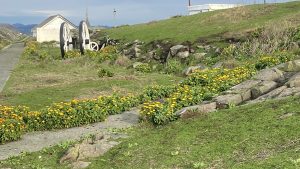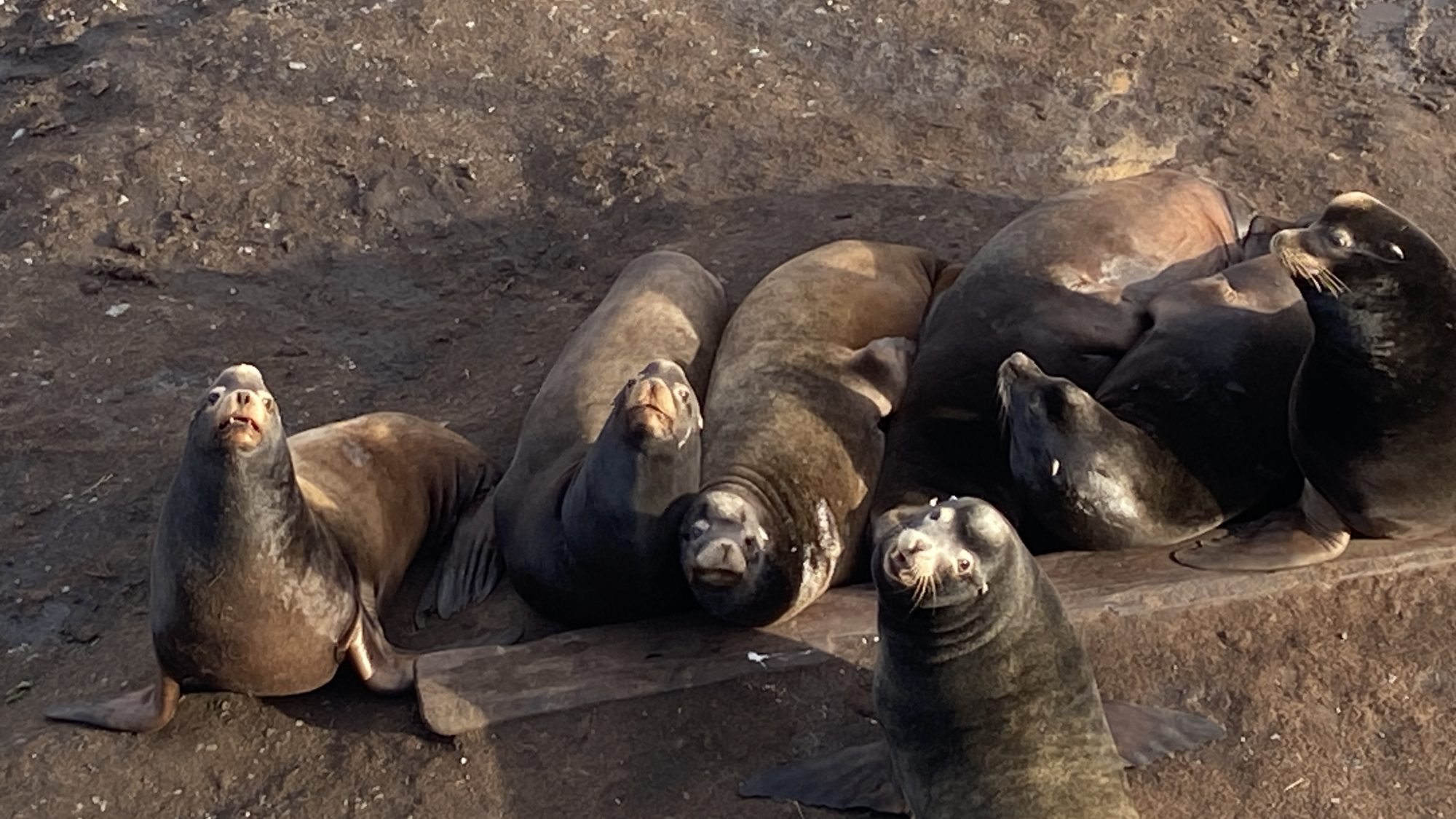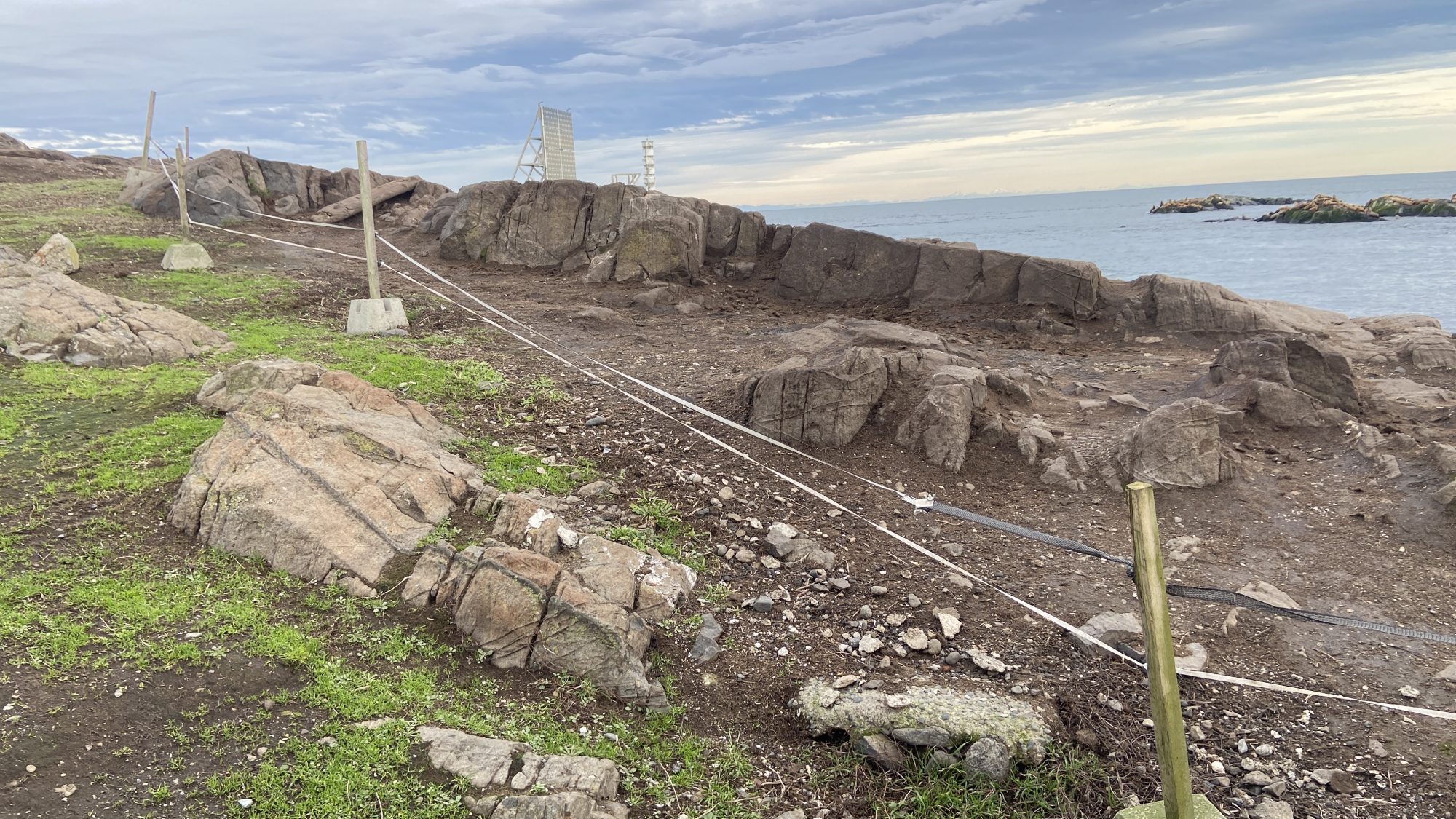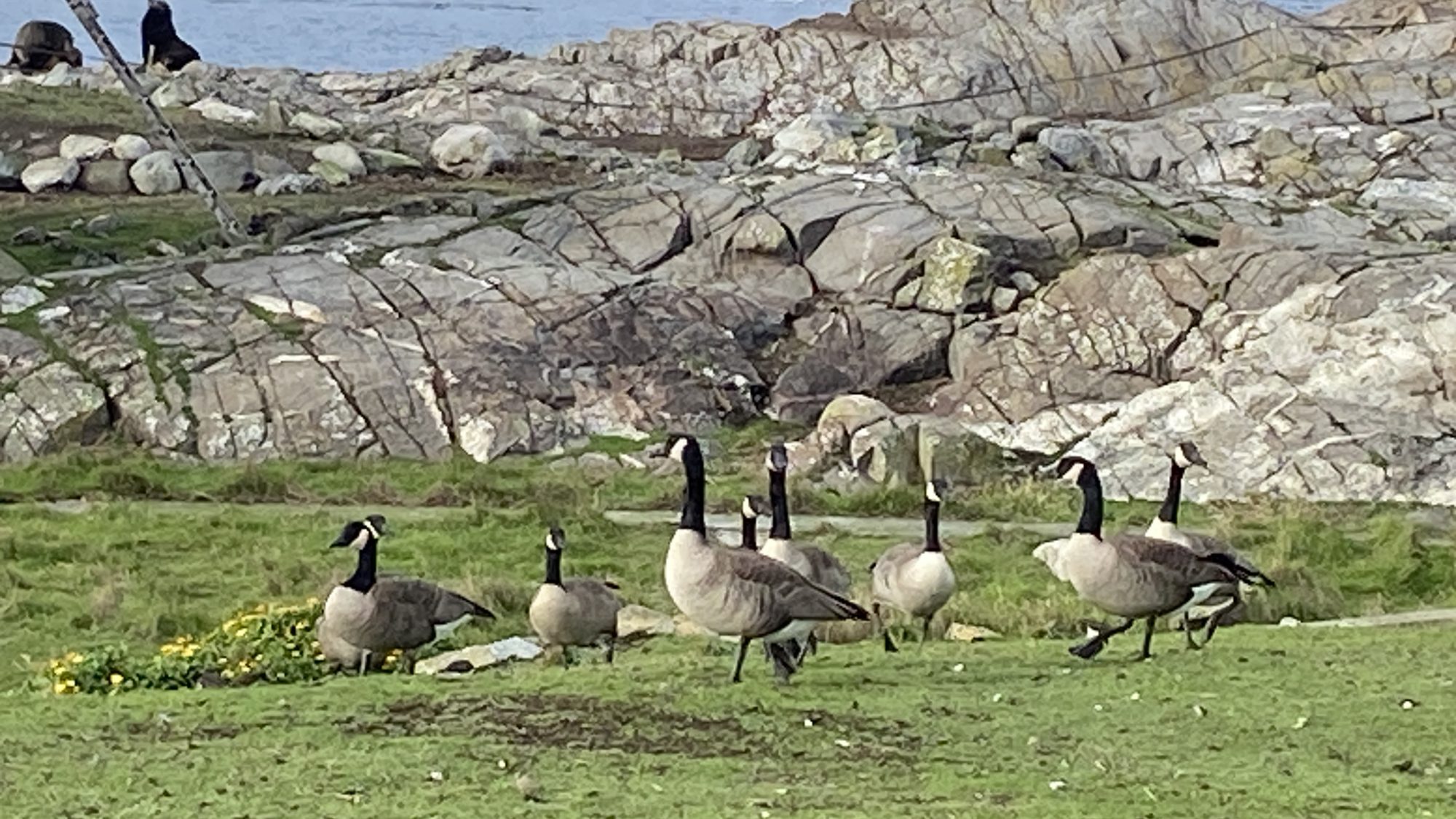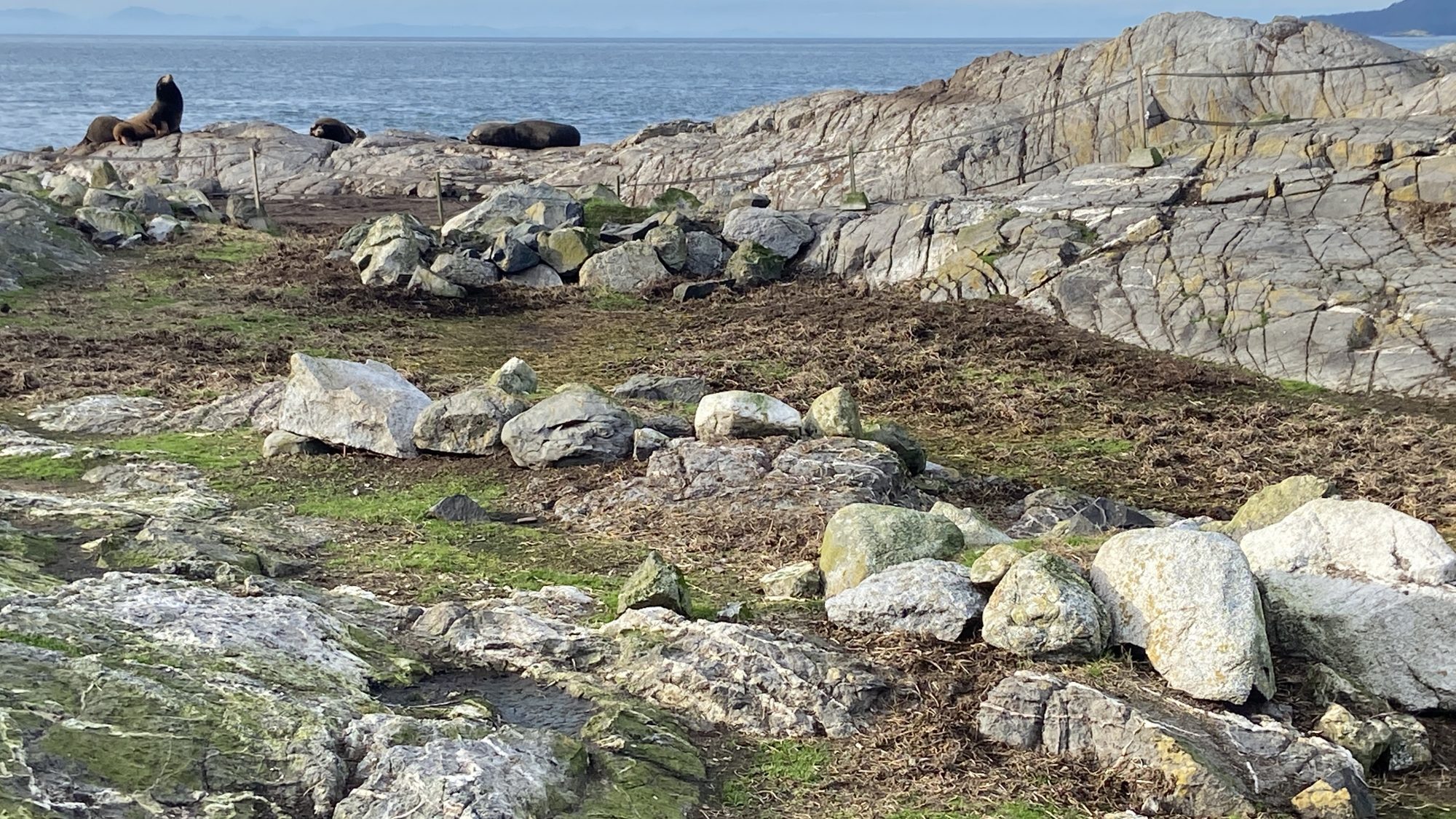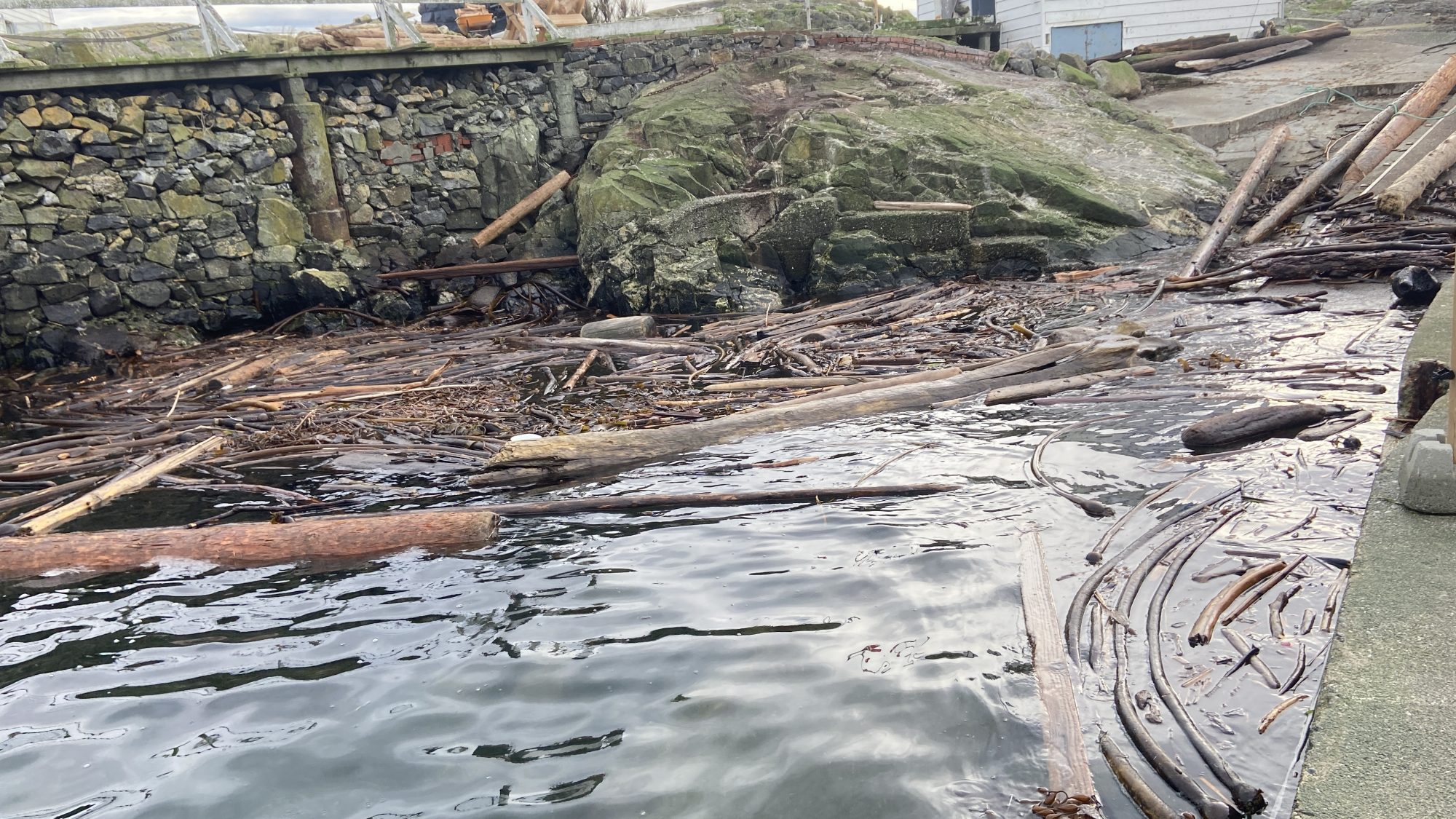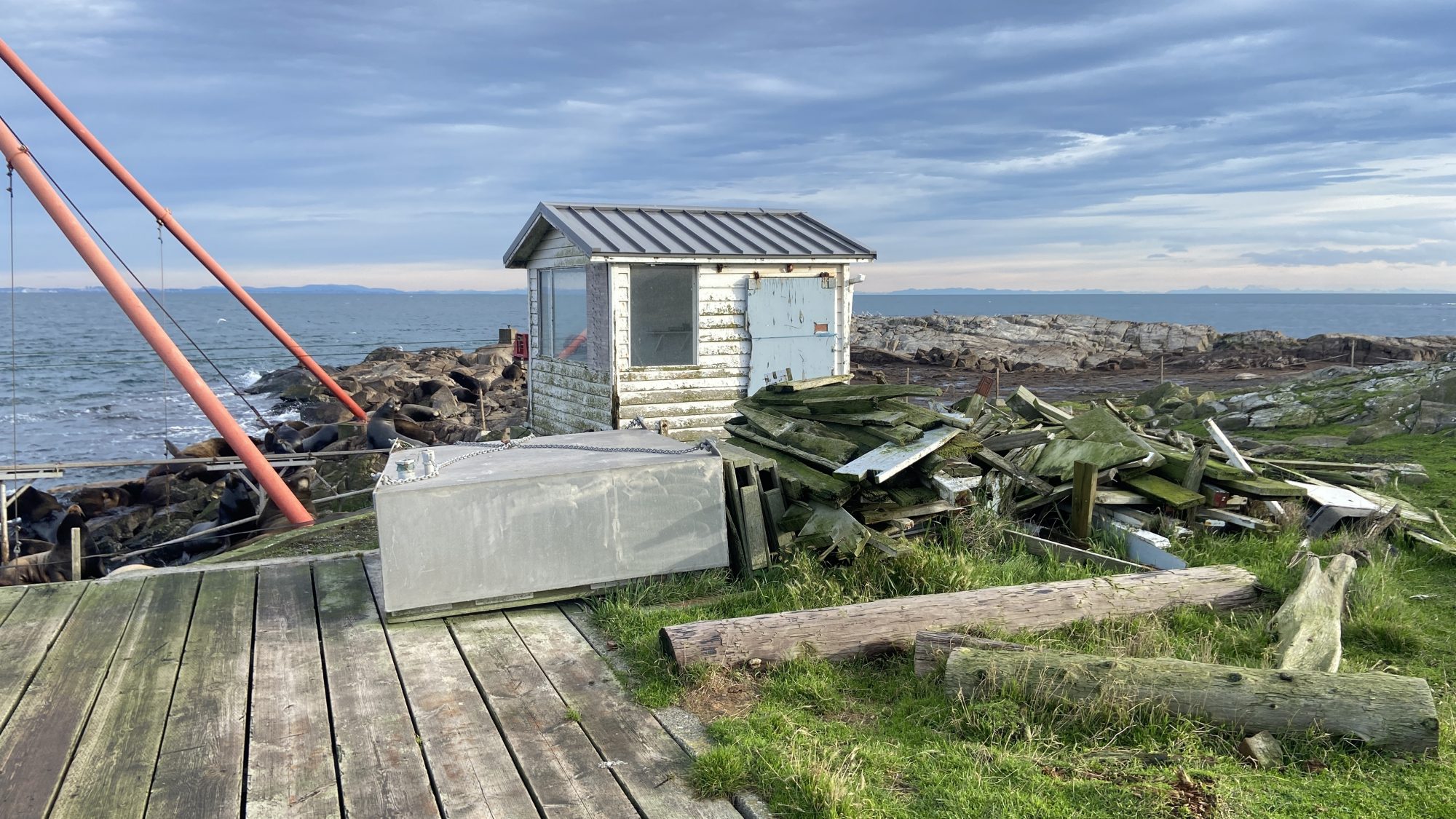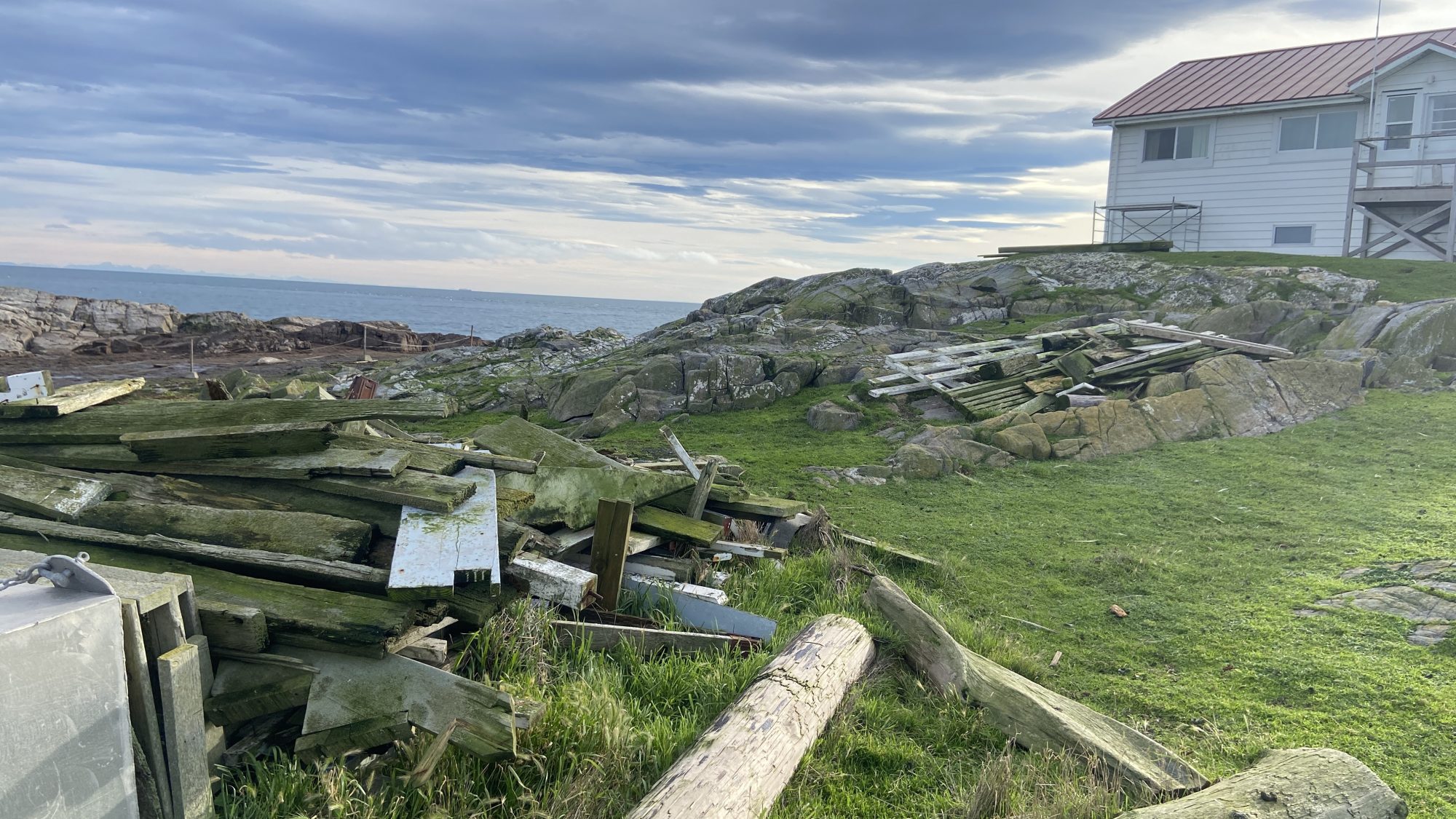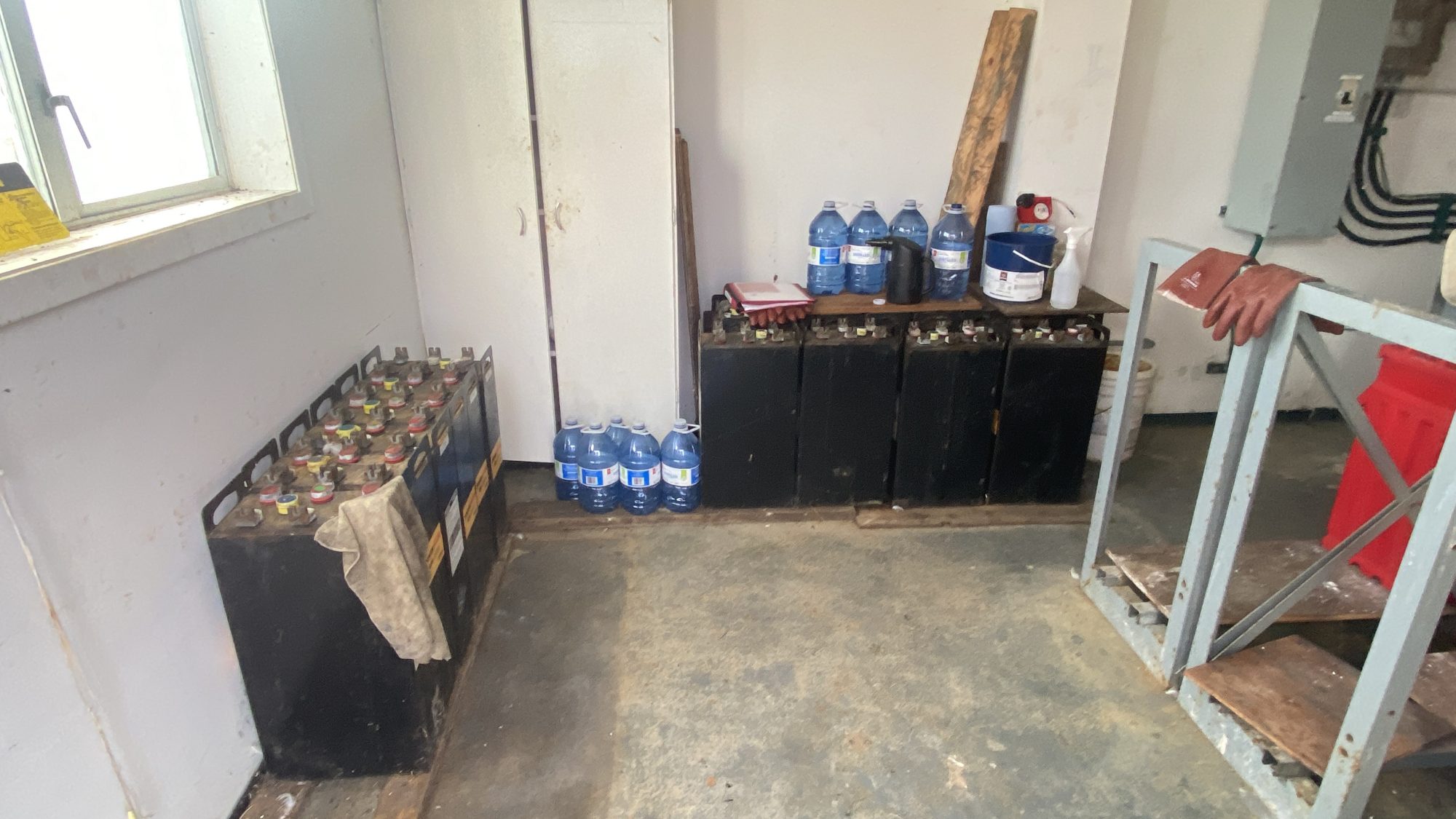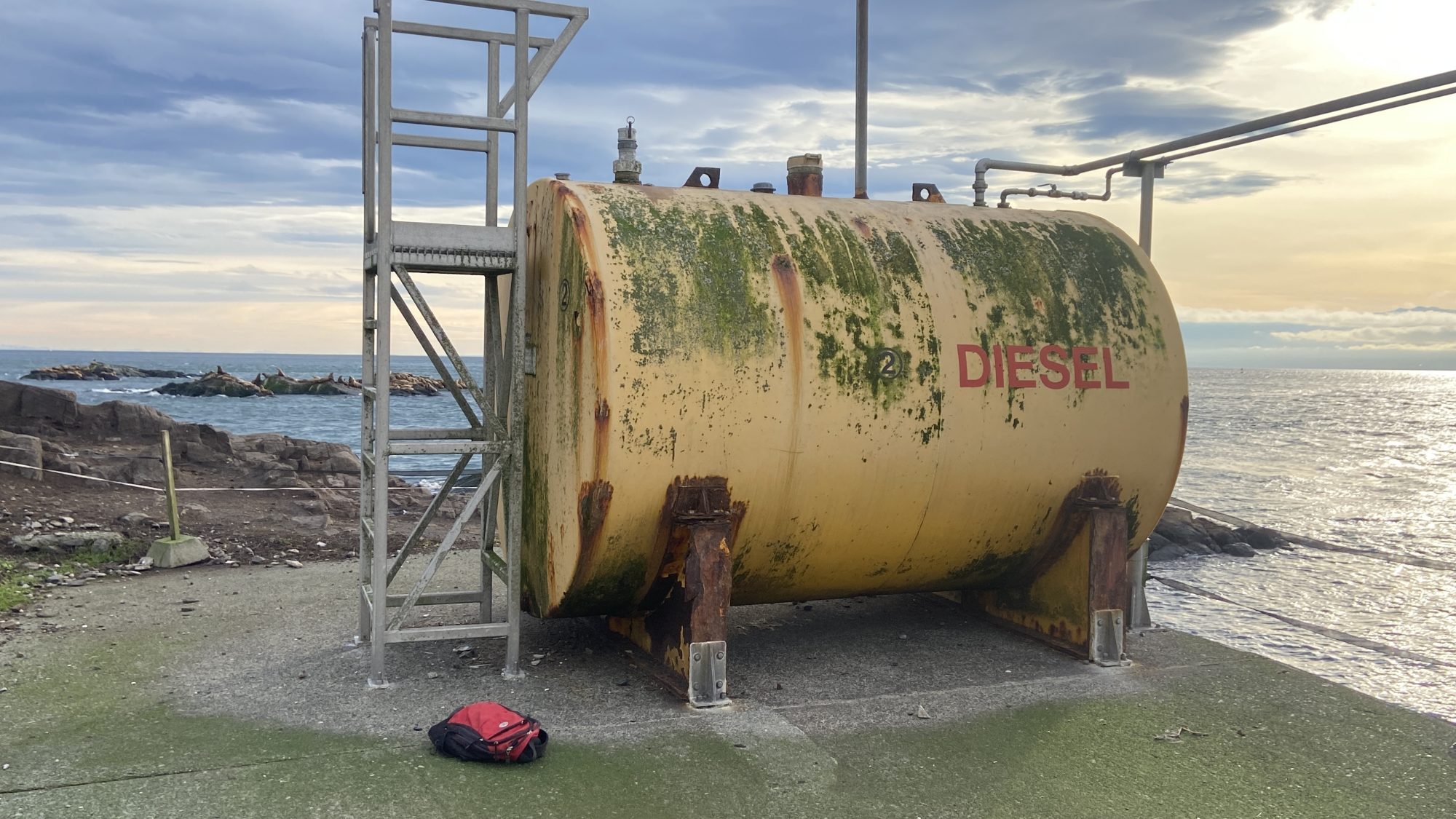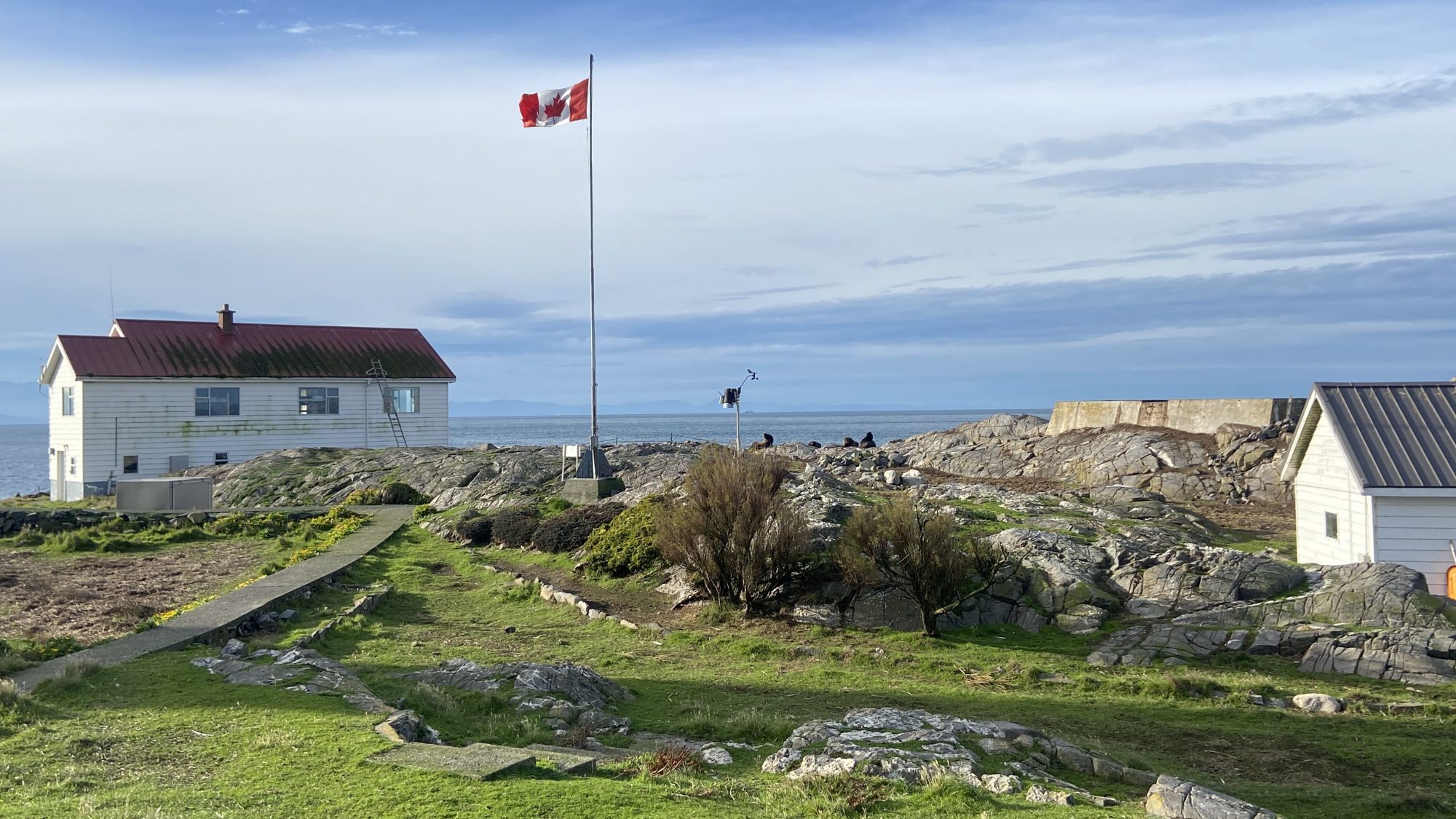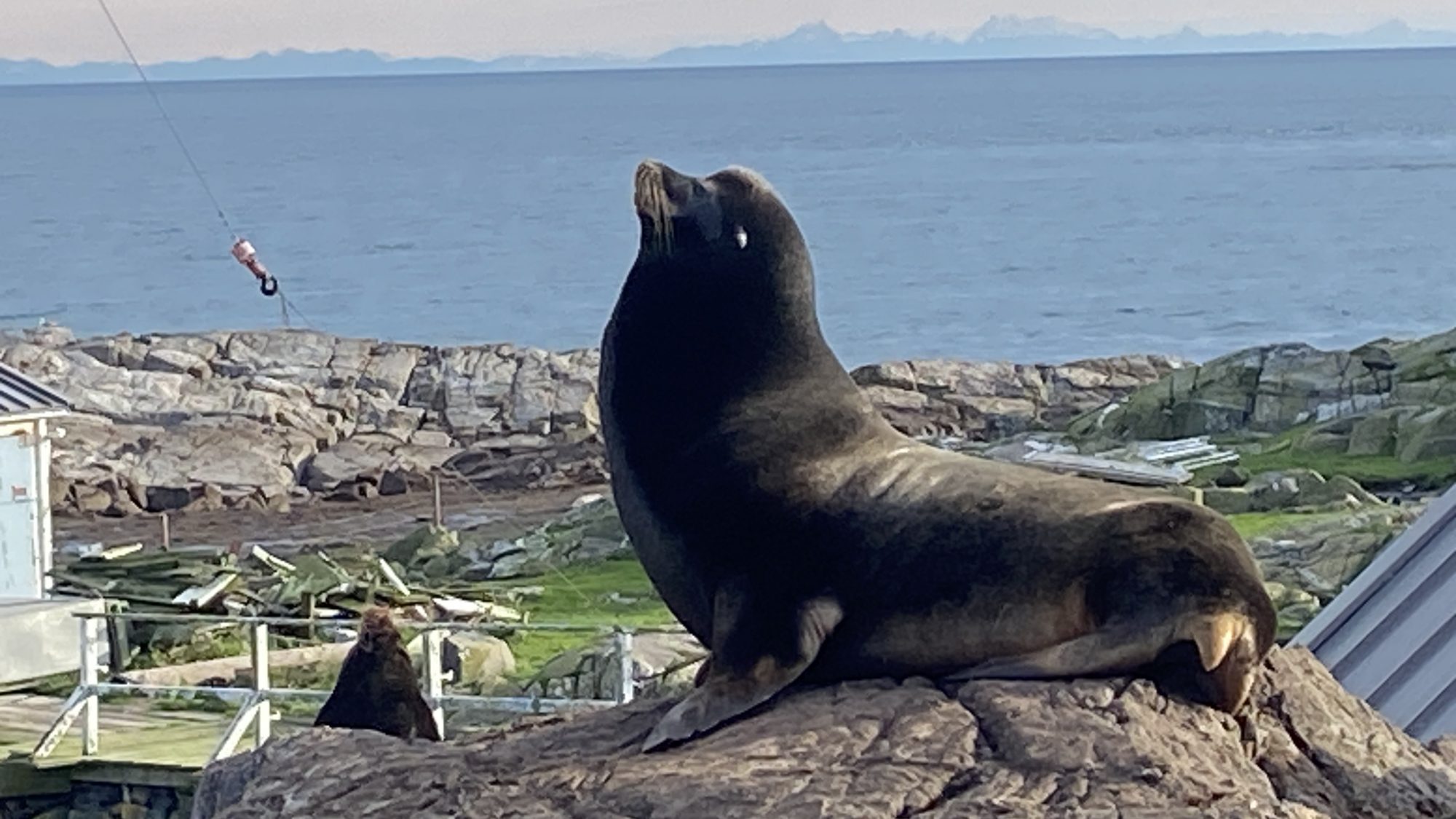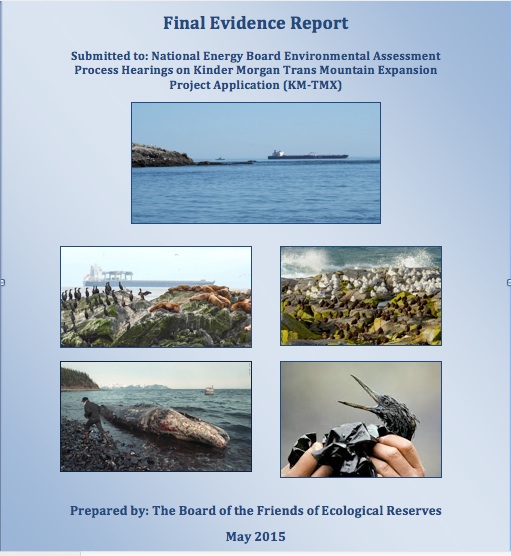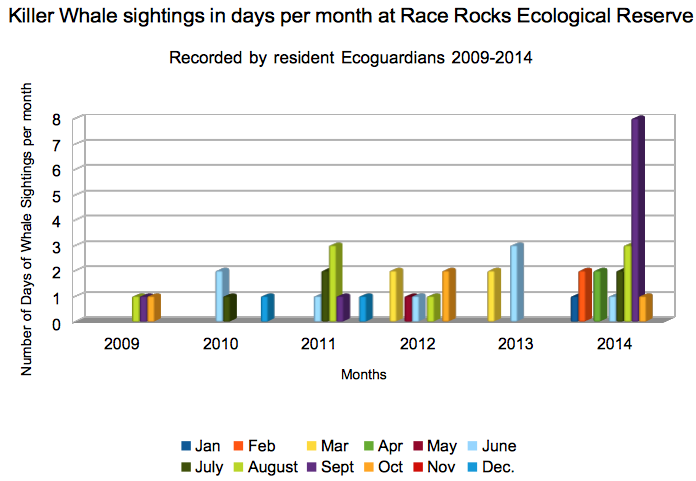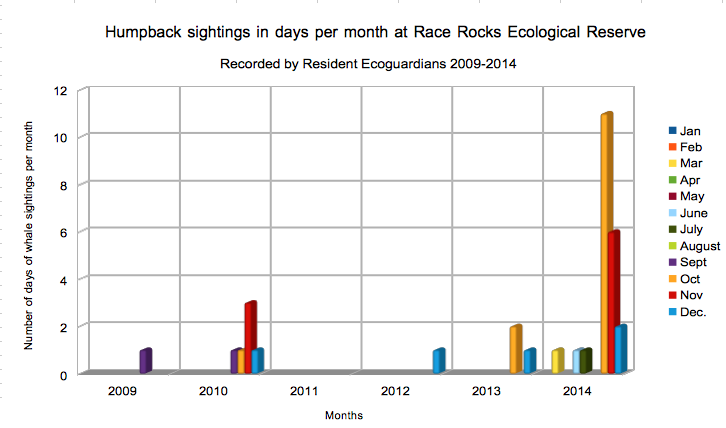The management Plan was produced many years ago and needs updating.
It can be found on the BC government website at:
https://nrs.objectstore.gov.bc.ca/kuwyyf/race_rocks_er_mp_20020515_502695e402.pdf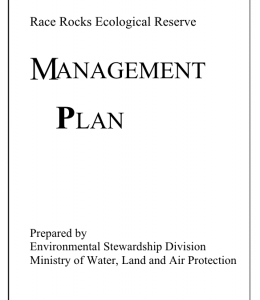
Category Archives: Reports
Race Rocks Ecological Reserve #97 Wardens Report December 2023
Wardens Report by Garry Fletcher.. December 13, 2023
Past Wardens reports may be accessed at https://racerocks.ca/category/er-warden-report/
I got a ride out on the Second Nature vessel of Lester Pearson College. Greg and Cedrick were taking out two technicians to deal with problems with the Solar panels and the diesel engine.
A herd of California Sea lions who have become accustomed to boats landing at the docks greeted us at the docks.
On the North side of the island there were mainly California sealions.
The Northern sealions predominated on the south side of the island Their distinctive growl and larger size sets them apart from the California Sea lions
- California Sea lions on the south side of the island
- Brian Blagdon from Viridian Power installing new parts on the stand
- Jordan Cole from Viriidian Energy Co-op upgrading equipment for the solar energy generation system
For the several hours that the technicians were busy in the engine room I could check out the whole island. Additional solar panels have been added to the array shown in the video below taken from the roof of the energy building/engine room. In the winter the diesel engine has to run for a few hours to help charge the batteries.
From the helicopter pad I observed a very nervous mixed herd of California and Northern sealions that were occupying the area on the West side of the island, preventing me from going in that direction to check out the tidepools.
- When walking around with Ecoguardian Derek Steriling, , we saw three elephant seals .
- We anticipate more of them to arrive in the next few weeks and look forwrd to the new pups that will be born in January
Race Rocks must be one of the few outdoor locations in British Columbia where flowers bloom year round because of the surrounding waters never dropping below 8 degrees C which moderates the temperature.
- Marigolds, planted years ago by the lightkeepers, thrive along the pathways .
- Where the sealions have hauled out , the vegetation is completley destroyed . In this area there were some Romanzoffia growing in past years but it is doubtful if they will be around now
- The Pearson College hired Ecoguardians have a continual job to do checking the temporary electric fence that cordons off the haulout areas from the vegetated part of the island
- The Canada geese however with their constant grazing , keep the grass suppressed
- In this area, although the sealions are fenced out, excessive grazing by geese damages the turf making the Indigenous burial cairns more susceptible to erosion and collapse.

There were many Black turnstones around the island. They are found here year round although they are not known to nest here.
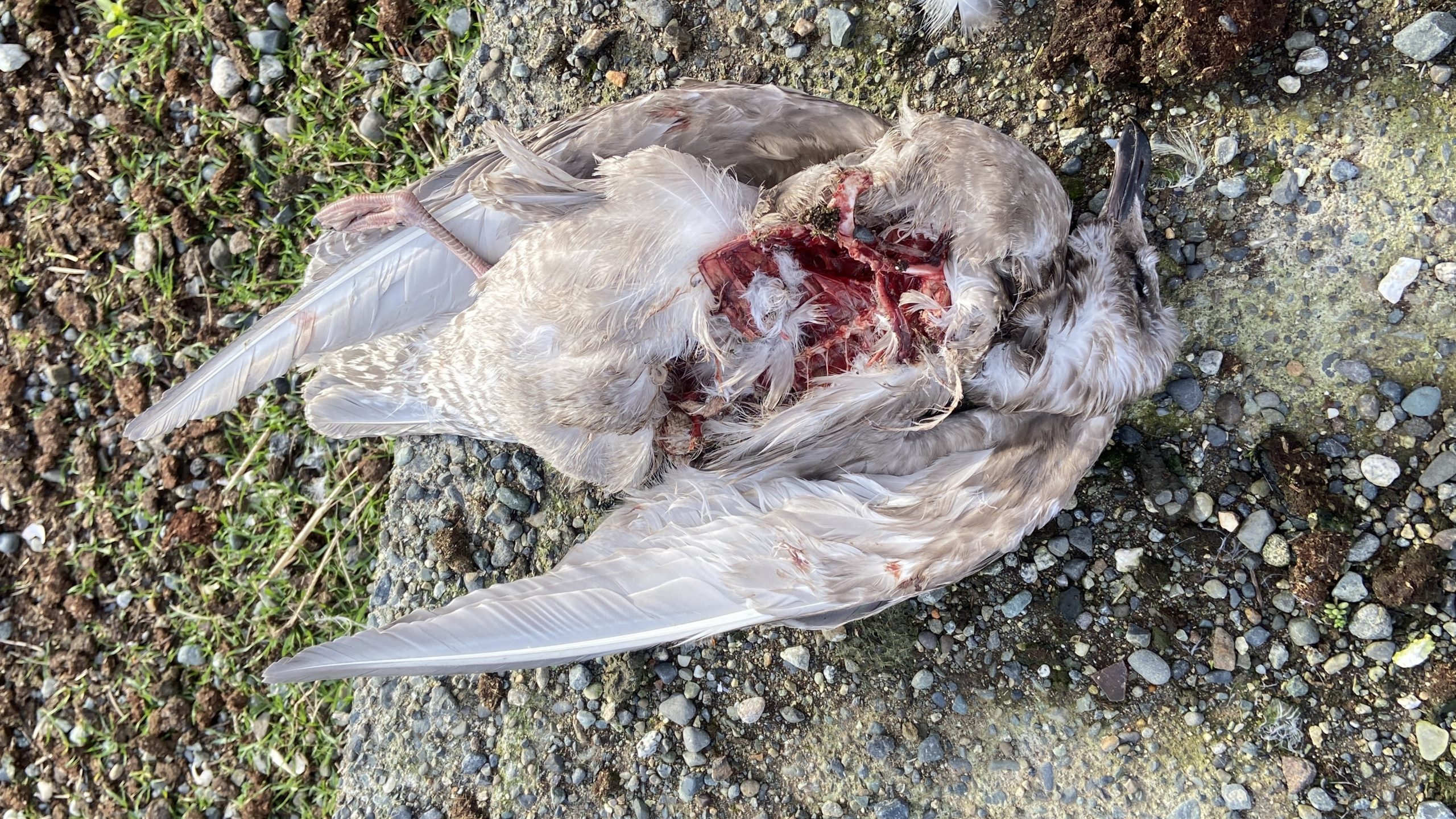 There has been a high number of gull mortalities this past year. This one is missing the breasts indicating it was a meal for the Bald Eagles. They now patrol the area regularly and this has probably contributed to the low number of overwintering gulls.
There has been a high number of gull mortalities this past year. This one is missing the breasts indicating it was a meal for the Bald Eagles. They now patrol the area regularly and this has probably contributed to the low number of overwintering gulls.
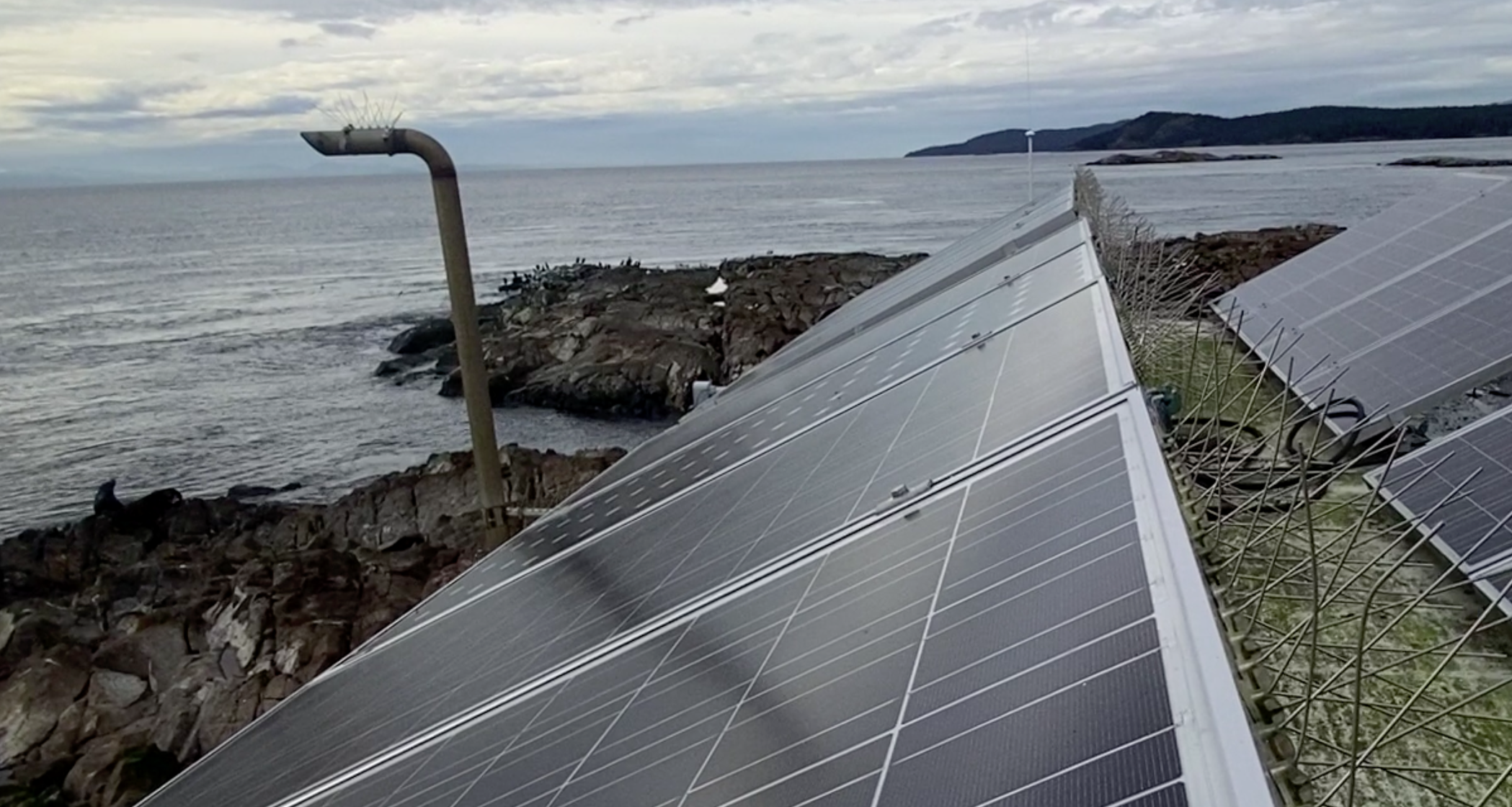 The absence in overwintering seagulls at this time of of year was very obvious. Ined some years they have number in the thousands. The south-west corner which usually is heavily populated only had a dozen of probably brants cormorants, and a small flock of less than 100 gulls was on the north-east corner of the island
The absence in overwintering seagulls at this time of of year was very obvious. Ined some years they have number in the thousands. The south-west corner which usually is heavily populated only had a dozen of probably brants cormorants, and a small flock of less than 100 gulls was on the north-east corner of the island
While I was there , Greg and Cedrick from Pearson College helped in cleaning gutters, definitely a two-man job for safety reasons, and hauling up some of the logs in the harbour by the slipway for cutting up for firewood.
- logs to haul up for firewood
- cleaning the gutters on the science house
SOME WORK YET TO BE DONE:
Managing a former light station and an Ecological Reserve can be a large job. Pearson College does an admirable job in fundraising to keep the place going. It is after all the only Ecological Reserve in the province which has human dwellings and a full time Ecoguardian paid for by Pearson College. Since 1997 Pearson College has taken on the role of management of these facilities which require constant upkeep in a very demanding physical and biological environment. I will point out several items below that are needing attention.
- For several years now this pile of lumber from the replacement of the balcony has been awaiting removal .
- BC Parks has indicated they would do it but getting action on it has not been successful.
- These are the new storage batteries for the island
- The old stotrage batteries remain in the battery room awaiting recycling.
This is the last of the old storage tanks used by the coastguard. They await removal. It is just a matter of time until the salty environment encouraging the rust could cause further problems.
Below are some suggestions I would like to make about things that are not urgent but to which attention may be paid in the future.
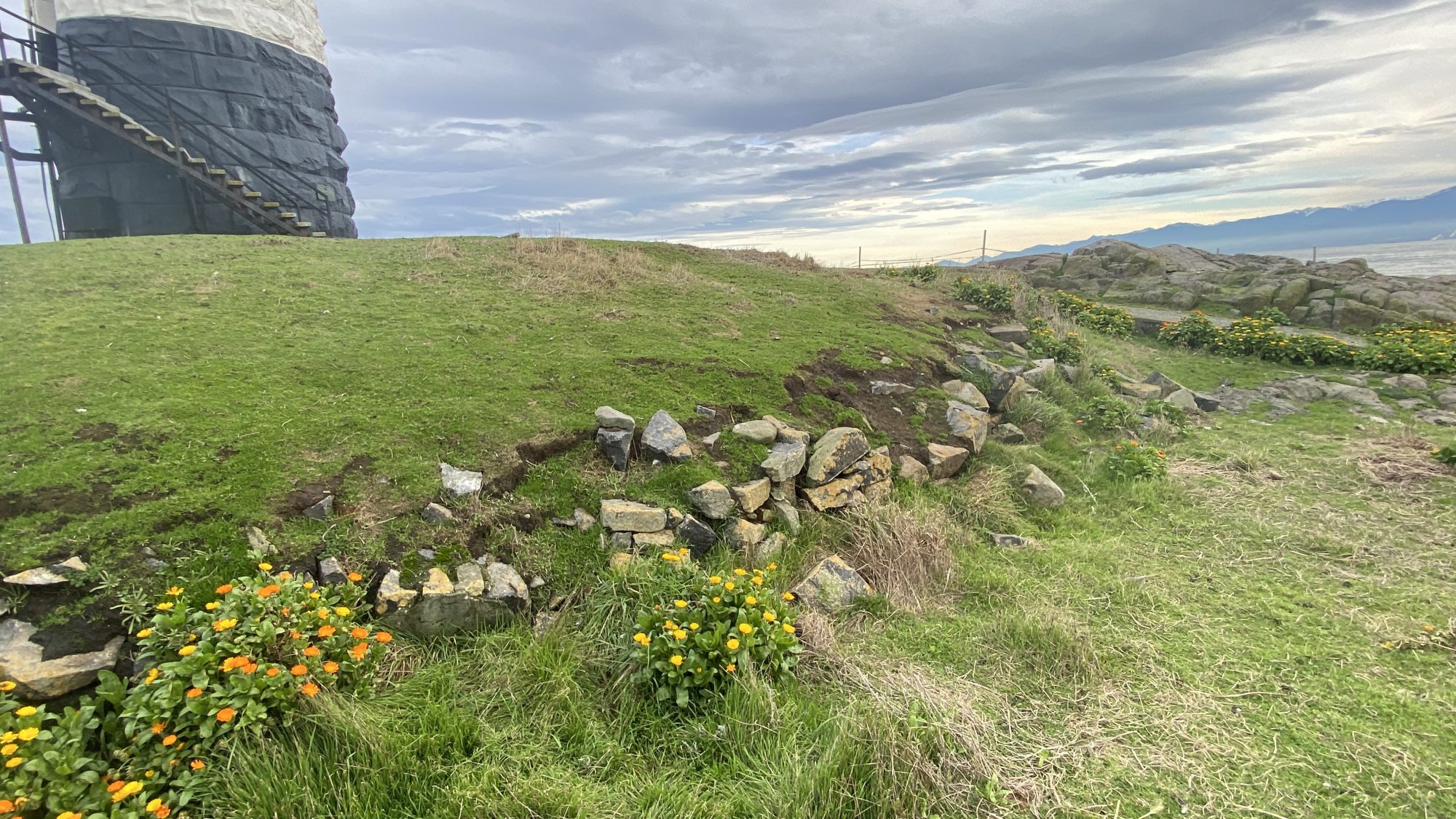 The rock wall which was eroded by the hurricane in 2006 Is still in a partly fallen state, contributing to bare soil and erosion. It wouldn’t take much effort to repair this to improve the stability of the area. ( maybe a student project week item?)
The rock wall which was eroded by the hurricane in 2006 Is still in a partly fallen state, contributing to bare soil and erosion. It wouldn’t take much effort to repair this to improve the stability of the area. ( maybe a student project week item?)
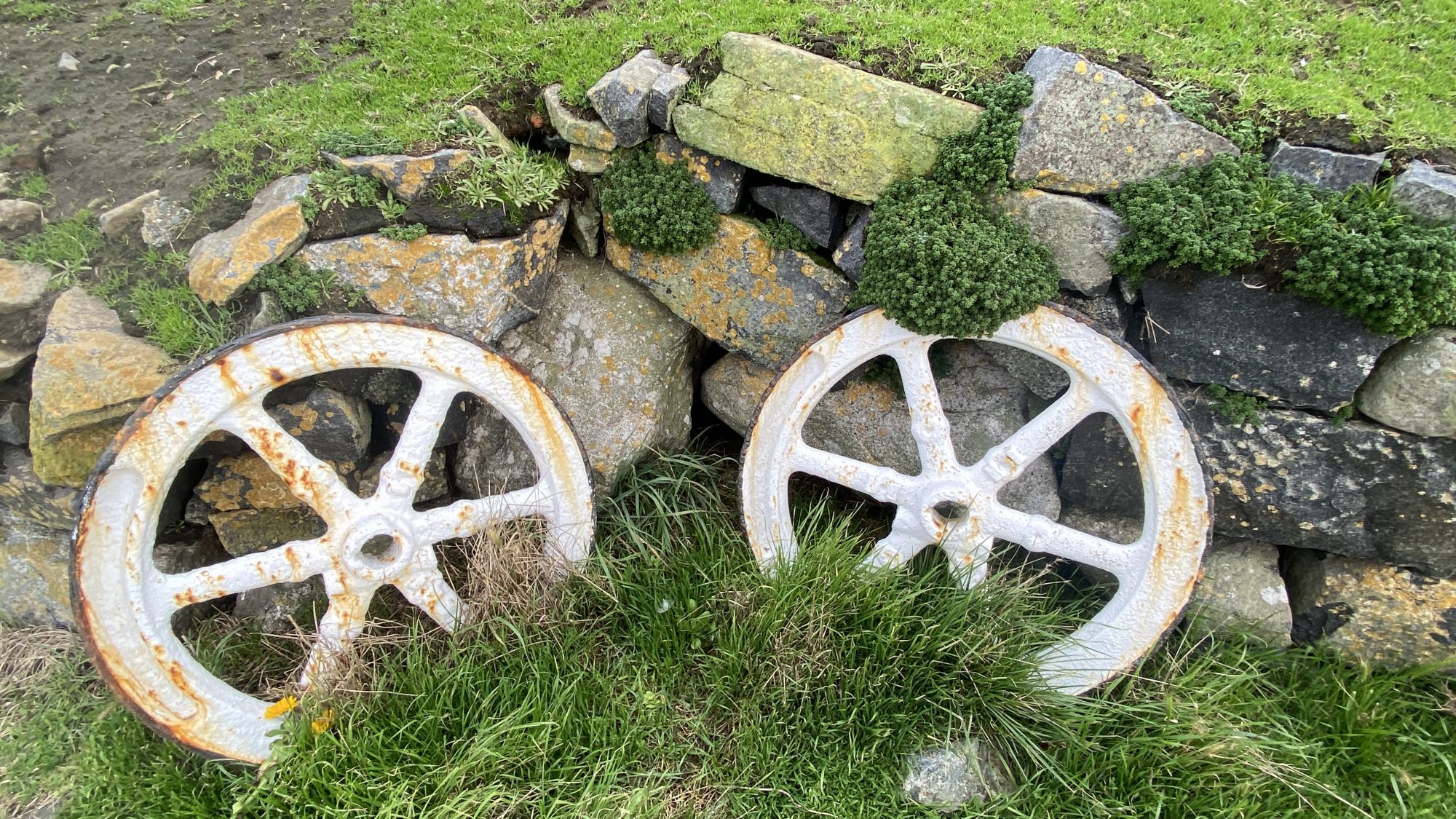 At one time the area under these artifacts was covered with bricks from the original engine room. The bricks are still there but they are now overgrown with grass. Removal of the overburden would improve the appearance of the area.
At one time the area under these artifacts was covered with bricks from the original engine room. The bricks are still there but they are now overgrown with grass. Removal of the overburden would improve the appearance of the area.
Race Rocks Ecological Reserve Proposed as a KBA – Key biodiversity area
 In June 2023 Ian Adams presented for the Annual General Meeting of Friends of Ecological Reserves on the Key Biodiversity Areas program in Canada. This presentation is available here: https://ecoreserves.bc.ca/2023/06/07/key-biodiversity-areas-ian-adams-fer-agm-june-2023/
In June 2023 Ian Adams presented for the Annual General Meeting of Friends of Ecological Reserves on the Key Biodiversity Areas program in Canada. This presentation is available here: https://ecoreserves.bc.ca/2023/06/07/key-biodiversity-areas-ian-adams-fer-agm-june-2023/
The website of KBA Canada is here: https://gis.natureserve.ca/portal/apps/dashboards/8a89d50ea0b04c7790e19791ab9ae6e8
Race Rocks Ecological Reserve is on the list of proposed KBAs in British Columbia along with several other Ecological Reserves in the province .
See the pdf: KBASummary_GeneralReview_XwaYeNRaceRocks_2023-06-19 KBASummary_GeneralReview_XwaYeNRaceRocks_2023-06-19
Below is a copy of that document.:
XwaYeN (Race Rocks) KBA, British Columbia
Northern Elephant Seal (Mirounga angustirostris)
Instructions for Reviewers
1. Read through the “Summary of Proposed KBA” section.
2. Answer the survey questions in the Online Review App.
3. For additional information, see:
What are KBAs and how are they assessed?
Instructions for reviewers
Summary of Proposed KBA
Please note that this summary was generated automatically, and as a result there may be species scientific names that are not italicized.
KBA Name: XwaYeN (Race Rocks)
Location (province or territory [mid-point lat/long]): British Columbia [48.297 /-123.53]
KBA Scope: National
Proposal Development Lead: Ian Adams
1.
5. Trigger Biodiversity Element(s):
● Species: Northern Elephant Seal (Mirounga angustirostris)
6. Site Status Summary:
XwaYeN (Race Rocks)
is a candidate National
KBA for the following KBA criteria:
● National D1a [criterion met by 1 taxon] – Site predictably holds an aggregation representing ≥1% of the national population size of a taxon,
over a season, and during one or more key stages of its life cycle (Mirounga angustirostris).
● National D1b [criterion met by 1 taxon] – Site predictably holds a number of mature individuals that ranks the site among the largest 10
aggregations known for the taxon in the country (Mirounga angustirostris).
7. Site Description:
The XwaYeN (Race Rocks) KBA overlaps with Race Rocks Ecological Reserve, which was created to protect intertidal and subtidal communities
that are extremely rich as a result of strong tidal currents. Energy and nutrient inputs attributable to the nearly continuous currents are large,
and light penetration in these shallow, clear waters is excellent. These factors result in a high production of algae and invertebrates, while the
varied topography promotes ecological diversity. Consequently, the marine communities here are unusually luxuriant and rich. XwaYeN is in the
Coastal Douglas-fir Moist Maritime biogeoclimatic zone (BC Parks 2022), though none of the islands are forested.
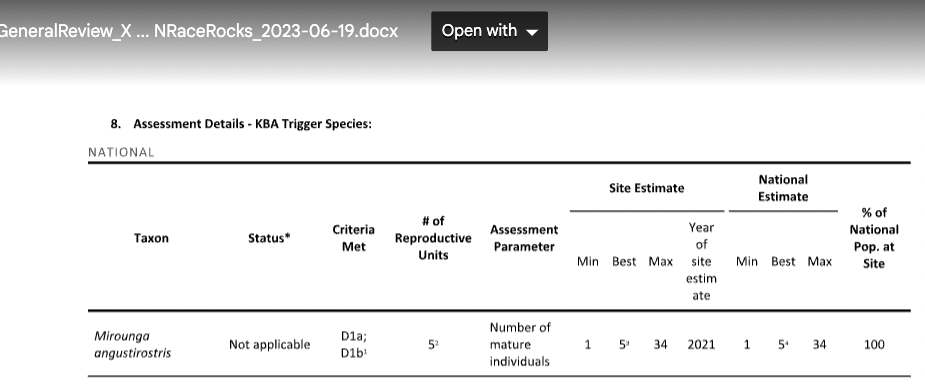
1 Meets criterion D1b because it is one of 10 largest aggregations in Canada for this taxon.
2 Composition of 10 Reproductive Units (RUs): Elephant seals are polygynous so 10 RUs is 10 adults females and 1 adult male. . Source of RU
data: IUCN 2016; Fletcher 2016; Race Rocks Ecoguardians 2022.
3 Derivation of site estimate: Other. Explanation of site estimate(s): Five Elephant seal pups were born at the site in 2021 (Race Rock
Ecoguardians 2022; BCCDC 2022). Race Rock Ecoguardian observation data collated for 1 Jan 2014 through 20 Jan 2016 found almost continual
presence of Northern Elephant Seal at Race Rocks. Counts range from 1 to 34 individuals, including all age classes: adults, sub-adults and pups.
A best estimate of 5 individuals is an approximate average during this time. Source(s) of site estimate(s): Race Rock Ecoguardians 2022;
Fletcher 2016; BCCDC 2022.
4 Explanation of national estimate(s): Five Elephant seal pups were born at the site in 2021 (Race Rock Ecoguardians 2022; BCCDC 2022). Race
Rock Ecoguardian observation data collated for 1 Jan 2014 through 20 Jan 2016 found almost continual presence of Northern Elephant Seal at Race Rocks. Counts range from 1 to 34 individuals, including all age classes: adults, sub-adults and pups. A best estimate of 5 individuals is an approximate average during this time. Source(s) of national estimate(s): BCCDC 2022; Race Rock Ecoguardians 2022; Fletcher 2016.
*The threat status displayed is the one that qualifies the species as a criterion A1 trigger under KBA rules, if applicable. Other statuses may exist.
9. Assessment Details – KBA Trigger Ecosystems: None
10. Delineation Rationale:
The ecological reserve boundary was followed due to the presence of rich intertidal and subtidal invertebrates that are not well documented as potential KBA eligible species. This also facilitates management options for the KBA.
11. Technical Review:
Name Affiliation Email
Garry Fletcher Lester B. Pearson College (retired); Director with Friends of Ecological Reserves Society garryf use the @ sign gmail.com
Strahan Tucker Fisheries and Oceans Canada Strahan.Tuckeruse the @ sign dfo-mpo.gc.ca
12. Additional Site Information:
Rationale for site nomination XwaYeN (Race Rocks) KBA is the only Northern Elephant Seal rookery in Canada. As such, it meets criteria as a national D1a and D1b KBA.
Additional biodiversity at the site A unique hydroid, Rhysia fletcheri, was described as a new species from this site (Brinckmann- Voss et al. 1993), but its abundance and range extent are unclear. Several bird species stop over at the rocks during migration,Including Red Knot (Calidris canutus roselaarim, COSEWIC. Threatened). There are nesting colonies for seabirds including Pigeon Guillemot (Cepphus columba), Black Oystercatcher (Haematopus bachmani) and Glaucous-winged Gull (Larus glaucescens). Brandt's Cormorants (Urile penicillatus) occur at the site but do not nest there.
Both Steller (Eumetopias jubatus, COSEWIC Special Concern) and California (Zalophus
californianus) sea lions use Race Rocks as a winter haul-out. Quillback rockfish (Sebastes
maliger, COSEWIC Threatened) are present and partially protected by a Rockfish Conservation Area (FAOC 2021, see Site Management). Plants including Sea Thrift (Armeria maritima) and Tracy’s Romanzoffia (Romanzoffia tracyi) are present. Rare lichens are present such as Orange Sea Lichen (Flavoplaca marina – previously called Caloplaca marina) and a Grey Lichen (Myriolecis straminea – previously called Lecanora straminea). Iceland Gull (Larus glaucoides) can be found in large numbers and will likely be added as a contributing species in the future.
A full list of species observed at the site is available at https://racerocks.ca/race-rocks-animals-plants/taxonomy-image-gallery/
Customary jurisdiction at site
Traditional territories of the Sc’ianew First Nation, Esquimalt First Nation, and T’Sou-ke First
Nation. Á,LEṈENEȻ ȽTE (W̱SÁNEĆ); Te’mexw Treaty Association; Douglas Treaty may include
Race Rocks.
Conservation:
The site is a BC Parks Ecological Reserve which is staffed and managed by Lester B. Pearson UWC (United World College). The site is part of a Rockfish Conservation Area, established by Fisheries and Oceans Canada to protect inshore rockfish;from all mortality associated with recreational and commercial fisheries; (FAOC 2021). Race Rocks is in Rockfish Conservation Area 19 (FAOC 2015). The KBA is within the Juan de Fuca Strait Ecologically and Biologically Significant Area (EBSA) identified by Fisheries and Oceans Canada as well as Critical Habitat for Southern Resident Killer Whale (Orcinus orca).
Ongoing conservation actions Formal education; Invasive/problematic species control; Resource & habitat protection;
Site/area management; Site/area protection; Training Ongoing threats Human intrusions ; disturbance; Pollution Conservation actions needed
Awareness ; communications; Compliance and enforcement; Formal education;
Invasive/problematic species control; Policies and regulations; Resource & habitat protection;
Site/area management; Site/area protection
13. References:
B.C. Conservation Data Centre. 2022. BC Species and Ecosystems Explorer. B.C. Minist. of Environ. Victoria, B.C. Available:
https://a100.gov.bc.ca/pub/eswp/ (accessed Mar 6, 2022).
BC Parks. 2022. Race Rocks detailed ecological reserve description. Available:
https://bcparks.ca/eco_reserve/racerocks_er/Race%20Rocks%20ER%2097.pdf?v=1646607034131 (accessed Mar 6, 2022).
Brinckmann-Voss A, Lickey DM, Mills CE. 1993. Rhysia fletcheri (Cnidaria, Hydrozoa, Rhysiidae), a new species of colonial hydroid from
Vancouver Island (British Columbia, Canada) and the San Juan Archipelago (Washington, U.S.A.). Canadian Journal of Zoology. 71: 401-406.
https://doi.org/10.1139/z93-056
Fisheries and Oceans Canada (FAOC). 2015. Rockfish conservation areas – Areas 19 and 20. Website: https://www.pac.dfo-mpo.gc.ca/fm-
gp/maps-cartes/rca-acs/areas-secteurs/1920-eng.html [accessed August 23, 2022]
Fisheries and Oceans Canada (FAOC). 2021. Rockfish conservation areas. Website: https://www.pac.dfo-mpo.gc.ca/fm-gp/maps-cartes/rca-
acs/index-eng.html#permit [accessed August 23, 2022]
Fletcher G. 2016. Marine Mammals Hauled out on Race Rocks Jan 2014-Feb 2016. online graph image available: https://racerocks.ca/marine-
mammals-hauled-out-on-race-rocks-2014-2015/ (accessed August 12, 2022)
Race Rocks Ecoguardians. 2022. Race Rocks species list and image gallery. Available: https://racerocks.ca/race-rocks-animals-
plants/taxonomy-image-gallery/ (accessed Mar 6, 2022).
Federal Government Report on Healthy Oceans
Committee report No. 14- FOPO (42-1) House of Commons
HEALTHY OCEANS, VIBRANT COASTAL COMMUNITIES: STRENGTHENING THE OCEANS ACT MARINE PROTECTED AREAS’ ESTABLISHMENT PROCESS — Report of the Standing Committee on Fisheries and Oceans … Bernadette Jordan Chair
Ed note: After two unsuccessful attempts to finalize the MPA designation for Race Rocks, I find it interesting to see this committee report so I have included the table of contents here , to see the complete document see this PDF FILE: included in the report are 25 recommendations.(.foporp14-e)
Link to the work done by the Race Rocks MPA advisory Board in two rounds of meetings– 1998-2010
TABLE OF CONTENTS
LIST OF MEMBERS
CONSERVATION OF MARINE BIODIVERSITY
C. Protected Areas: Definitions and Guidelines
D. Oceans Act Marine Protected Areas
CURRENT CRITERIA AND PROCESS USED TO IDENTIFY AND ESTABLISH OCEANS ACT MARINE PROTECTED AREAS
B. Science-Based Decision-Making
1. Selecting Areas of Interest
2. Community-driven Protection
3. Establishing a Marine Protected Area
C. Transparency With Regard to Consultations
1. Indigenous Rights and Interests
E. Plan to Achieve Canada’s Marine Conservation Targets
ENVIRONMENTAL IMPACTS OF MARINE PROTECTED AREAS
A. A Precautionary Ocean Management Tool
B. Maximizing Marine Biodiversity Benefits
SOCIO-ECONOMIC IMPACTS OF MARINE PROTECTED AREAS
A. Impacts on the Fishing Industry
2. Concentrating Fishing Efforts
B. Impacts on Subsistence Harvesting by Indigenous Peoples
C. Impacts on the Shipping Industry
ENHANCING THE OCEANS ACT MARINE PROTECTED AREAS’ ESTABLISHMENT PROCESS
A. Transparency: Ensuring a Comprehensive Consultation Process
2. Consultation Inclusiveness and Sharing of Information
2.2 Providing Relevant Information
2.3 Marine Conservation Led by Resource Users
2.4 Terminology and Concurrent Processes
3. Public Comment Periods and Proposed Regulations
B. Role of Science: Ensuring Science-Based Decision-Making
C. Protection Standards: Ensuring Marine Biodiversity Benefits
D. Recognizing Community and Indigenous Conserved Areas
E. An Integrated Process: Marine Planning
1. Planning Frameworks and Partnerships
2. Integrated Marine Planning Processes
APPENDIX C: TRAVEL TO CANADA – WEST COAST From May 28 to June 2, 2017
APPENDIX D: TRAVEL TO CANADA – EAST COAST From October 16 to 20, 2017
REQUEST FOR GOVERNMENT RESPONSE
SUPPLEMENTARY OPINION OF THE CONSERVATIVE PARTY OF CANADA
SUPPLEMENTARY OPINION OF THE NEW DEMOCRATIC PARTY OF CANADA
Concern for the 19 Marine Ecological Reserves which could be affected by the KM/TMX pipeline.
The Board of Friends of Ecological Reserves, submitted their final report as Intervenors in the National Energy Board Hearings on the Kinder Morgan Trans Mountain Expansion Project.
http://ecoreserves.bc.ca/2015/
Misleading information in recent STANTEC report on Whales.
Also see the APRIL 23 post with graphs on Whale Observations from Race Rocks 2009-2014.
I believe that the increasing frequency in recent years in the number of humpback whales observed in the area which will be affected by increased tanker traffic from the Kinder Morgan/ TMX project has not been taken into account In the Consultant’s report issued today “ Quantitative Assessment of Increased Potential for Marine Mammal-Vessel Interactions from the Trans Mountain Expansion Project TRANS MOUNTAIN PIPELINE ULC TRANS MOUNTAIN EXPANSION PROJECT –-Prepared by: Stantec Consulting Ltd. 500 – 4730 Kingsway Burnaby, BC, V5H 0C6 Ph.: (604) 436-3014,
Quoted from the report :
“While the BC CSN data includes numerous opportunistic sightings of humpback whales in the study area over the course of the last four decades, the majority of the Marine RSA is generally not recognized as a humpback whale hotspot, although the western extent just overlaps with the eastern-most extent of humpback whale critical habitat –(Fisheries and Oceans Canada 2013a). As such, and since actual humpback whale density values for the Marine RSA (Regional Study Area) do not exist, this species was assigned a density according to the lowest density observed for humpback whales during the surveys reported on in Best and Halpin (2011) elsewhere in BC ((Williams and Thomas 2007) did not observe any humpback whales during their summer 2004 survey in this area) This value corresponds to roughly 10 whales distributed across the majority of the Marine RSA
——As a result, humpback whales were assigned a proportion of time in the study area of 0.17 (i.e., two months of the year) based on the largest concentration of sightings from the BC CSN data (British Columbia Cetacean Sightings Network 2013)”
Here is a good example, in my opinion, of how a decision having long term implications regarding the welfare of a species recovering from near extinction may be completely misdirected if based only on a consultants interpretation of officially published scientific resources which can quickly become dated.
G.Fletcher
2009-2014 Whale Observations from Race Rocks
Lester Pearson College has employed the Ecoguardians at Race Rocks Ecological Reserve since 1997. One of the benefits of this is in having observers on site 24 hours on this archipelago in the Strait of Juan de Fuca. A great amount of citizen science is achieved as they record in their logs the events such as whale sightings of the area.
In the past year I have been working as an intervenor for the Board of Friends of Ecological Reserves to try to question and advise the National Energy Board and the Kinder Morgan Corporation on the problems of increasing the traffic of oil tankers from the Westridge terminal through the Strait of Juan de Fuca. The area of potential impact from chronic and catastrophic oil spills puts at risk the ecological integrity of up to 17 of our Marine Ecological Reserves around southern Vancouver Island. In our submission I was able to draw upon the records from the Race Rocks Ecoguardian’s logs to demonstrate the increase in the incidence of whales in this area. A recent report of the Department of Fisheries (Sufficiency Review of the Information on Effects of Underwater Noise and the Potential for Ship Strikes from Marine Shipping on Marine Mammals in the Facilities Application for the Trans Mountain Expansion Project )has criticized the Environmental assessment done by Trans Mountain as being ineffective to take account of the increasing potential of Impact on the large whales such as humpbacks and the underwater noise which will masking of the ability of whales to communicate and get food.
I put together the following graphs to show the increase in the number of days per month that whales were observed from Race Rocks:
Thanks to Ryan, Raisa, Adam, Alex, Virginie, Julie, Courtney, Nick, and Anne for contributing to this database.
Addendum : see the April 27 post on the report issued today ” Quantitative Assessment of Increased Potential for Marine Mammal-Vessel Interactions from the Trans Mountain Expansion Project TRANS MOUNTAIN PIPELINE ULC TRANS MOUNTAIN EXPANSION PROJECT –Prepared by: Stantec Consulting Ltd. 500 – 4730 Kingsway Burnaby, BC, V5H 0C6 Ph.: (604) 436-3014,
Garry Fletcher, Race Rocks Ecological Reserve Warden.
New DFO Report highly critical of Kinder Morgan /TMX environmental assessment on Whales
The recentlly released DFO report:
(See Full PDF) SUFFICIENCY REVIEW OF THE INFORMATION ON EFFECTS OF UNDERWATER NOISE AND THE POTENTIAL FOR SHIP STRIKES FROM MARINE SHIPPING ON MARINE MAMMALS IN THE FACILITIES APPLICATION FOR THE TRANS MOUNTAIN EXPANSION PROJECT was very critical of the Trans Mountain Expansion Project Application documents. The Conclusion of the report is concerned with Vessel strikes on Whales and the overall impact of noise from increased Project-related traffic. Included below are the conclusions of the report.
Conclusions
There are deficiencies in both the assessment of potential effects resulting from ships strikes and exposure to underwater noise in the Trans Mountain Expansion Project Application documents.
There is insufficient information and analysis provided with which to assess ship strike risk in the Marine RSA from either existing or Project-related traffic. Ship strike is a threat of conservation concern, particularly for baleen whales such as Fin Whales, Humpback Whales and other baleen whales (Gregr et al. 2006). If shipping intensity increases as projected in Section 4.4 in the Marine RSA and the Strait of Georgia and Juan de Fuca Strait as a whole, the significance of this threat to cetacean populations that occupy the region will increase.
Incidence of recovered whale carcasses is not considered to be an adequate measure of the frequency of ship strikes. No information is provided about the speed and maneuverability of Project-related ships or the distribution of whales in relation to the shipping lanes. Analyses that consider the statistical probability of ship-whale encounters and the risk of collisions are considered appropriate methodologies to assess this potential effect.
The JASCO MONM model, as it has been applied by the Proponent, is not adequate to assess the overall impact of noise from increased Project-related traffic. Although state-of-the-art acoustic modelling has been used to model the noise propagation associated with a single Project-related tanker in the Marine RSA, only four locations were chosen to represent the Marine RSA; therefore, the assessment does not adequately represent the noise exposure for the entire time a marine mammal would be in the RSA. The assessment represents only Project-related tanker traffic and not the current noise environment or the potential increase due to Project-related traffic. Finally, the method used to assess the significance of impacts from the modelled noise level contours resulting from a single Project-related tanker and tug on indicator cetacean and pinniped species is qualitative and the lack of an appropriate assessment framework reduces DFO’s ability to evaluate the assessment.
See other posts on Oil Spill Risk for the Race Rocks Ecological Reserve
The Tidal Current Turbine Energy Project in the Race Rocks Ecological Reserve
Erika Lee Brown Memorial University of Newfoundland St. John’s, Newfoundland, Canada
ABSTRACT
the full PDF can be linked here:tidalenergyreport
There is a predicted potential of 42 000MW stored in tidal energy off the coast of Canada which remains widely untapped by the energy industries.[1] Although there has been significant research and development done in the tidal energy sector, it has been a challenge to develop a cost efficient system which has a minimal environmental impact.
In 2006, the first tidal current generator to be built and installed in Canada was deployed north of the Middle Islands in the center of the Race Rocks Ecological Reserve off the coast of British Columbia. The current generator prototype was part of a six year joint research venture between Clean Current and the Race Rock project. The project aided to power Race Rocks using a combination of alternative energy technology to minimize the environmental impact of the facilities in the reserve while providing bases for testing of structural materials of the generator.
After numerous interruptions in power supply were experienced due to mechanical and electrical problems, the final phase of the project was completed in September 2011. The generator was retrieved from the seabed and transported to Vancouver for structural analysis.
The following paper will discuss the parameters of the study, as well as the challenges and problems encountered with the deployment, maintenance and retrieval of the tidal current system. A brief investigation of the outlook of tidal current generator systems as a means of power generation within Canada will also be completed.
See the full PDF: http://journals.library.mun.ca/ojs/index.php/prototype/article/view/397/496
Responses of Steller Sea Lions (Eumetopias jubatus) to In-Air Blast Noise from Military Explosions
Read more:referenced 2002 http://www.readperiodicals.com/201207/2767584211.html#ixzz3O0yxtiXa
The Steller sea lion (Eumetopias jubatus) is a species of conservation concern and is protected from anthropogenic disturbances by federal legislation in Canada and the United States. Although the breeding population has tripled since intensive culling ended ~40 y ago, conservation concerns persist due in part to the species’ vulnerability to anthropogenic factors, including noise. Published data on the nature and consequences of Steller sea lion responses to loud, impulsive noises such as explosions are sparse, yet useful where important haulouts are adjacent to such events. Herein, we document the short-term behavioural responses of Steller sea lions on a winter haulout complex to military explosions on southern Vancouver Island, Canada, over a period spanning 1997 to 2010. Blasting activities have been ongoing for over 70 y, involving ordnance disposal and on-land demolition training with high explosives-both of which disturb pinnipeds at nearby Race Rocks Ecological Reserve (RRER). Acoustic measurements confirmed that in-air noise reached levels capable of causing pinniped disturbance (i.e., > 109 dBF peak) but not injuries such as a permanent threshold shiftin hearing (i.e., < 149 dBF peak). Sea lions showed a significant increase in activity following blasting and were commonly displaced from haulouts. Within minutes of the disturbance, however, activity levels dropped sharply, and displaced animals usually began returning to haulouts. Activity levels on the day after blasting were similar to levels on days prior to blasting. General linear models showed no evidence (2 models) or no conclusive evidence (1 model) of an effect of blasting on sea lion abundance. Repeated exposure to in-air blast noise has short-term effects on Steller sea lions at RRER. We speculate that long-term effects on sea lions using RRER are unlikely-especially considering the increase in the peak numbers of Steller sea lions at RRER in recent decades while blasting has been ongoing. Key Words: Steller sea lion, Eumetopias jubatus, C4, disturbance, explosion, harassment, military, noise, ordnance, Race Rocks, Salish Sea, eastern stock.
Author: Demarchi, Mike W
Date published: July 1, 2012
IntroductionA segment of the eastern stock of Steller sea lions (Eumetopias jubatus) occurs year-round in the marine waters of British Columbia (BC), Canada. There are four breeding areas in BC, and a number of others between Cape Suckling, Alaska, and California, and these sea lions also use numerous other locations along the coast as year-round or winter haulout sites (Fisheries and Oceans Canada, 2011). Hauling out at non-rookery sites confers a number of benefits to sea lions, including rest; decreased risk of predation by killer whales (Orcinus orca); and opportunities for nursing, grooming, and social interaction. Race Rocks Ecological Reserve (RRER) is one of at least 26 major haulout sites in BC that are used only by nonbreeding animals primarily during autumn and winter (Fisheries and Oceans Canada, 2011; LGL Limited, unpub. data); both sexes and all age-classes occur at RRER. Based on re-sight data from branded animals (Edgell & Demarchi, in press), RRER is used by Steller sea lions that breed in California, Oregon, and Alaska. The extent to which Steller sea lions from rookeries in BC use RRER is not known because no extensive branding or tagging studies have been conducted in BC. However, considering that the nearest rookeries in Canadian waters (i.e., Scott Islands) are closer than those in the U.S., we suspect that many of the Steller sea lions at RRER are from Canadian rookeries. Abundance of Steller sea lions in RRER varies by season and year, with counts ranging from 0 to 680 animals (Edgell & Demarchi, in press). However, the actual number of animals that use RRER during peak years is expected to be considerably greater as they use RRER as a temporary stopover while moving into and out of the Salish Sea. RRER is also frequented by California sea lions (Zalophus californianus), harbour seals (Phoca vitulina), and northern ele-phant seals (Mirounga angustirostris).The Steller sea lion is presently listed by the Committee on the Status of Endangered Wildlife in Canada (COSEWIC) as a species of Special Concern and is on Schedule 1 of the Canadian Species at Risk Act (SARA). It is the subject of a federal management plan that identifies acute noise disturbance as a management concern (Fisheries and Oceans Canada, 2011). In the U.S., the eastern stock of Steller sea lions, which extends from southeast Alaska to California, is listed as Threatened under the Endangered Species Act. Prior to garnering protection in Canadian waters under the Fisheries Act in 1970, and under the U.S. Marine Mammal Protection Act in 1972, Steller sea lions were extensively culled in an effort to reduce real or perceived conflicts with commercial fish-eries (Fisheries and Oceans Canada, 2011). Since then, the eastern stock has increased through 2002 (the year of the last range-wide survey) at a mean annual rate of 3.1% (Pitcher et al., 2007), and the number of breeding animals in Canadian waters has tripled (Fisheries and Oceans Canada, 2011).
At haulout sites, Steller sea lions are susceptible to disturbance and commonly enter the water when disturbed (e.g., Harestad, 1978; Lewis, 1987; Kucey, 2005; this study). The adaptive significance of this response is unclear given that overall mortality risk is likely greater in water (e.g., killer whale preda-tion, entanglement) than on land. However, such a response is appropriate in light of their vulnerabil-ity to harm by humans with rifles. Beyond RRER, sea lions are commonly shot for First Nations’ sub-sistence harvesting (e.g., as authorized under the Nisga’a Final Agreement and under Alaskan Native subsistence harvest agreements), animal control at aquaculture facilities (e.g., Hume, 2000; we note that in a recent review of human-caused mortality of Steller sea lions, Allen & Angliss 2012, indi-cated by way of a pers. comm. with P. Olesiuk that aquaculture facilities in BC have been forbidden from shooting Steller sea lions since 2004; how-ever, news reports of Steller sea lions being shot at aquaculture facilities do occur occasionally), and as perceived competitors with commercial fish-ing interests. Lewis (1987) reported that neonate Steller sea lion pups on a rookery were trampled to death by adult sea lions fleeing humans approach-ing by foot, but the extent of such mortality was low. Kucey (2005) documented numerous occa-sions of Steller sea lion disturbance, but no conse-quent injuries or mortalities were reported. Tershy et al. (1997) and Holcomb et al. (2009) concluded that human disturbance of California sea lions was short-term and localized.
The Marine Mammal Regulations under the Fisheries Act prohibit people from disturbing any marine mammal in Canadian waters unless authority has been granted by the federal government. Those regulations are not based on empirical evidence of harmful effects of disturbance but, rather, on the premise that interfering with the normal life functions of a marine mammal exposes it and its population to risks. It therefore follows that conservation interests can be served by managing risk exposure. However, if the putative disturbance has no negative implications for population conservation, or even if the population consequences are sustainable, restricting human activities such as military training or ecotourism for the sake of preventing disturbance could have negative social or economic consequences that might not be justified by the restrictions. That said, the use of best practices toward achieving environmental sustainability dictates that viable options to integrate human activities with the interests of marine mammal ecology should be identified and implemented whenever possible.
Canadian Forces Base (CFB) Esquimalt and Canadian Forces Ammunition Depot (CFAD) of the Canadian Department of National Defence (DND) oversee exercises and operations involving explosives in Marine Training and Exercise Area WQ at Rocky Point on southern Vancouver Island, BC. The Rocky Point property was selected and subsequently appropriated by the DND in 1955 as the site for the West Coast ammunition depot, thereby replacing the Colwood depot in Esquimalt Harbour (Mathews, 2004). The training that occurs at Rocky Point has been ongoing for over 70 y and includes defensive exercises, service battalion training, and demolitions training (Ferg, 1996). Such training is imperative for those members of the Canadian Forces that are engaged in both domestic and foreign operations. To this day, Rocky Point is still the largest terrestrial training area under the administration of the CFB Esquimalt and plays an integral role in supporting the DND’s activities both on land and at sea. In order to aid in maintaining the current level of operational capability of the Canadian Forces, a high tempo of training is carried out at Rocky Point year-round and will continue into the foreseeable future.
Military activities involving explosives are known to disturb Steller sea lions and other pinnipeds at nearby RRER, and the in-air audiogram of Steller sea lion (Muslow & Reichmuth, 2010) confirms that blast noise is audible to this species. Ferg (1996) identified information gaps in our understanding of the implications of military training for Steller sea lion ecology in RRER. Since then, pinniped monitoring has taken place intermittently in conjunction with DND activities. We selected the Steller sea lion as the focal species for this study because of the four species of pinniped that occur at RRER, it has the highest conservation status (listing) and has been observed to be the most responsive to acoustic disturbances. In support of this goal, the research objectives of this program were to document the responses of Steller sea lions to military explosions and to quantify the short-term effects on the use of RRER by those animals. Depending on the nature of the short-term effects, the potential for long-term effects, which are far more complicated to measure and detect, might be gauged.
Materials and Methods
Study Area
Marine Training and Exercise Area WQ is located on Rocky Point, southern Vancouver Island, BC (48° 19’12” N, 123° 33’13” W). Two ranges within WQ are used for ordnance-based demolitions training: (1) the Whirl Bay Underwater Demolition Range and (2) the Bentinck Island Demolition Range (Figure 1). The Bentinck Island Demolition Range is used for above-water beach-clearing and obstacle-creation exercises (e.g., metal cutting and the displacement and demolition of rocks and logs). The range is used for up to ~12 training courses per year, each spanning 1 to 4 d. With the exception of one or two night courses annually, all blasting occurs during daylight hours.
During the study period, demolitions (aka projects) at Bentinck Island comprised up to a maximum of four slabs of C4 plastique. C4 is a white, plastic high explosive made of RDX (Royal Demolition Explosive; aka cyclonite or hexogen; chemical name, trinitrotriazine) and an inert plastic binder. On a typical day, one to three projects are detonated in a run (or series) with ~30 s to 5 min or more between projects and ~15 to 120 min between two to four runs (i.e., 4 to 12 blasts in total). Some project locations have a direct line-of-sight to most of RRER, and others are separated to a modest degree by beach and island topography. The nearest haulout used by seals and sea lions in RRER is ~1.3 km from the blasting site at Bentinck Island.
Surplus ordnance is disposed of on an as-needed basis on the Christopher Point Ordnance Disposal Range, which has a line-of-sight to RRER (Figure 1). Up to 12 detonations can occur per day. Use of the range varies greatly among years, but it is typically used fewer than 25 d/y. The nearest haulout used by pinnipeds in RRER is ~2.0 km away from the detonation site at Christopher Point.
The pinniped study area comprised the exposed portion of RRER (Figure 1). RRER is a complex composed of one island (Great Race Rock: 1.48 ha; 48° 17’55” N, 123° 31’54” W) and a number of smaller rocky islets and reefs. To facilitate animal counts and account for the spatial separation of individual haulouts within the RRER complex, the pinniped study area was subdivided into 14 sub-areas (haulouts) that varied in size and extent of use by pinnipeds. Terrestrial vegetation occurs only on Great Race Rock and consists of grasses and small forbs of both native and Eurasian origin. Great Race Rock has a number of buildings and infrastructure, including an automated light station operated by the Canadian Coast Guard. RRER is in the Salish Sea near the eastern end of Juan de Fuca Strait and is in the Nanaimo Lowland Ecosection of the Eastern Vancouver Island Ecoregion of the Georgia Depression Ecoprovince (Demarchi et al., 1990). The climate of the study area is mild, being moderated by the Pacific Ocean. Tides are semidiurnal with strong diurnal inequality. Actual tide height ranges between -0.367 and 3.707 m (chart datum), and tidal flow through Race Passage can reach 13 km/h.
Acoustic Monitoring
In-air sound levels of blast noise reaching Great Race Rock were obtained using a Larson Davis System 824 logging sound level meter (SLM), equipped with a 0.64-cm free-field microphone and windscreen during 4 d in 2007. The SLM logged broadband sound levels at Great Race Rock during the blast noise trials. Pressure waveforms from the SLM microphone were digitally recorded at 48-kHz sampling rate with 24-bit resolution for subsequent spectral and waveform analysis. The microphone was oriented toward Bentinck Island in a line-of-sight and was mounted on a tripod at a height of 170 cm above ground level near the northern limit of Great Race Rock nearest Bentinck Island.
The recording system was calibrated at the start of each day using a Larson Davis CAL200 94/114 dB re 20 µPa sound calibrator. The microphone was located ~1,950 m from the demolition area which is ~200 m (11%) farther from Bentinck Island than the main Steller sea lion haulout in RRER (i.e., “middle” rock; see Figure 1). The following three sound pressure level (SPL) metrics are presented: (1) peak SPL (the maximum instantaneous pressure level over the pulse duration), (2) impulse time-weighted SPL (i.e., the rms [root mean square] pressure level computed using a 35 ms exponential time-weighted moving average); and (3) 1 s energy equivalent SPL (denoted Leq) (i.e., the maximum rms pressure level over a fixed 1 s time window encompassing the pulse). The flat-weighted 1 s Leq was numerically equal to the unweighted sound exposure level (SEL) for exposure to single blast events since the duration of the measured blast pulses was less than 1 s. Both flat-weighted (i.e., unweighted) and A-weighted SPLs are presented, in units of dBF and dBA, respectively, in order to facilitate comparison of the results of this work to other studies.
A parabolic-equation-based atmospheric sound propagation model (INPM) was used to estimate the noise footprint of Bentinck Island blast operations. The model accurately computes frequency dependent sound propagation, accounting for diffraction, air turbulence, and ground interaction. Ground elevation data for the modeling area were obtained in the form of standardized 3 arc s resolu-tion Digital Terrain Elevation Data (DTED) files. Atmospheric wind and temperature profiles were measured using a weather balloon probe launched from the CFB Esquimalt MetOc station (CWPF), located ~15 km northeast of RRER. A single balloon launch was performed between 0800 h and 1000 h local time on each day of noise measurements. Modeling was performed in standard 1/3-octave fre-quency bands from 6.3 to 630 Hz.
Sea Lion Monitoring
The study focused on demolitions conducted on Bentinck Island, but detonations on Christopher Point were occasionally monitored because of their potential to disturb pinnipeds. We did not conduct a thorough study of the underwater demolitions in Whirl Bay, though we know from previous work that the in-air noise levels of underwater explosions are greatly reduced compared to in-air noise levels of above-water detonations (LGL Limited, unpub. data, 1997 to 2010).
Observations of Steller sea lions on haulouts were made by two biologists using binoculars and a spotting scope from atop the lighthouse on Great Race Rock (Bushnell 8 × 40; 15 to 45 × 60; ~30 m above sea level; ~650 m to farthest haulout) intermittently from 1997 to 1998, 2002 to 2003, and 2007 to 2010. On several occasions in 2008 it was necessary to count sea lions on part of one haulout from the water during daily boat trips to and from RRER because animals had shifted to a previously unused part of the haulout that was not visible from the tower. Most observations occurred during the peak of sea lion abundance, September to January. For Bentinck Island, monitoring was conducted on days prior to blasting (Pre-Blast BI), during blasting (Blast BI), and following blasting (Post-Blast BI), though not all Bentinck Island monitoring was part of such a sequence. For Christopher Point, monitoring only took place on days when detonations occurred. Pre-Blast BI monitoring provided a measure of baseline conditions ≥ 1 d prior to demolition exercises or ordnance disposal. Post-Blast BI monitoring provided an indication of animal abundance and behaviour 1 d after blasting. From the light tower, we maintained radio or visual contact with military personnel regarding the blasting schedule. Blasts, as heard by the observers, were noted to the nearest second.
Morning (AM) and afternoon (PM) censuses of Steller sea lions in RRER (i.e., all haulouts) provided information about daily changes in the total number of animals using the study area. The morning census occurred prior to any blasting. With one exception, the afternoon census occurred after the last blast of the day. Only animals that were supported by terrestrial features (i.e., islands, islets, rocks, jetty, etc.) were counted because of the difficulties in seeing and counting animals in the water. Although some animals were hidden from view, in our opinion and based on our familiarity with the area (including views from the water during travel to and from the island), most (> 90%) hauled-out individuals were visible from the tower. Crowding also may have biased the estimates because some animals obscured our view of others-especially when they were resting in the prone position. Increased activity (e.g., heads up) sometimes resulted in a higher and more reliable sea lion count per a given haulout.
Scan sampling of Steller sea lions on specific haulouts (sub-areas) within RRER allowed us to evaluate differences in behaviour and haulout density pre- and post-disturbance. Whereas the twice-daily census tallied all animals in RRER, scan samples comprised animals on a subset of haulouts in RRER, and, as such, the reactions of all Steller sea lions in RRER to disturbance stimuli were not monitored. Haulouts monitored for scan sampling were selected and sampled in the morning (prior to any blasting) and had ≥ 10 animals present during the first sample. Those haulouts were then monitored throughout the remainder of the day. Behaviour was defined as active or inactive. An active animal was one with its head up, was moving about the haulout, or was engaged in social interaction as per Harestad (1978). Counts of Steller sea lions on sub-areas selected for daily monitoring prior to any blasting were usually made at ~30 to 60 min intervals during the observation period, plus additional counts were made immediately before and in the minutes following a run (or projects within a run if time between projects permitted). Post-blast counts were made soon after all animals entered the water or it was apparent to the observer that movement to the water had largely ceased. Two visible measures of disturbance were recorded: (1) the relative change in behaviour (i.e., activity level) and (2) the change in number of animals hauled out after a disturbance as compared with before the disturbance. The proportion of active animals (i.e., activity level) was calculated by dividing the number of active individuals by the total number in a given sub-area. Displacement from a given haulout was quantified by comparing sequential samples.
Environmental data were collected periodically throughout all monitoring days. These data were recorded at the start and end of each day (approximately concurrent with the AM and PM census events), and whenever weather changed notably. Environmental parameters included air temperature, wind direction and speed, Beaufort sea state, swell height, cloud cover, precipitation, and tidal height. Swell height was recorded as a categorical variable with four levels (none, low, medium, high). Precipitation was recorded as a categorical variable with five levels (none, fog, light rain, hard rain, snow). Wind data were obtained from Coast Guard instrumentation on the light tower. Hourly tide data were obtained from Fisheries and Oceans Canada for Victoria Harbour.
Activity Analysis
Activity data were imported to MS Excel and SYSTAT 12 for graphing and statistical analyses. Activity data (percentages) were arcsine transformed before analysis, and the homogeneity of variance was examined using Levene’s test. Activity data were analyzed using ANOVA and Tukey HSD tests. Activity data were averaged over the course of a day because daily averages were more appropriate for statistical testing than individual values obtained from repeated observations of the same animals on the same day. To account for potential biasing effects of proportions resulting from samples with few animals, in addition to testing all records involving ≥ 1 animal, we set an arbitrary minimum threshold of 10 or 50 animals, depending on the analysis.
Census Analysis
Census data from eight monitoring sessions comprising consecutive pre-blasting (1 d), blasting (1 to 4 d), and post-blasting (1 d) days were compared. In addition, census data were analyzed with general linear models (GLM) using R, Version 2.13.2. Three such analyses were conducted, each using different predictive parameters to examine the effect of blasting. In the first analysis, a continuous blast parameter called “Blast Number” was used. It was the number of blasts that occurred leading up to the associated census observation. For all AM censuses, the Blast Number was 0. For PM censuses, the Blast Number was the number of blasts that had occurred on the monitoring day prior to the census (PM Blast Number was 0 on non-blasting days). In the second analysis, two categorical blasting parameters were used: (1) “Blast-day” (yes/no) and (2) “Census” (AM/PM). For this analysis, a statistically significant interaction between these two parameters would indicate an effect of blasting (i.e., the AM/PM sea lion counts would be expected to vary on days when blasting occurred but not on non-blast days). In the third analysis, a categorical blasting parameter called “Day-type” was used. Day-type categories included “pre-blast days,” “blast days,” and “post-blast days.” Because data from only 5 d of blasting on Christopher Point were collected, they were excluded from all three analyses. The first two analyses included 144 censuses, recorded on 72 d (2/d) between 2002 and 2010 (not all environmental data were collected in 1997). Data for the third analysis were restricted to the PM censuses.
For all models, the number of sea lions hauled-out was the response variable. As is typical when the response variable is a count, the models were initially run with a Poisson error distribution (Crawley, 2007). Initial tests showed strong evidence of overdispersion (the residual deviance was much greater than the residual degrees of freedom), thus all subsequent models were run using an overdispersed Poisson error distribution (i.e., “quasi-Poisson”).
As a starting point for all three analyses, the models included the full suite of environmental variables as covariates. Some environmental variables were included “as measured,” including air temperature, Beaufort sea state, cloud cover, and tide height. Both swell height and precipitation were recorded with too much precision, and categories needed to be pooled for analysis. Swell height was collapsed to three categories (none, low, and medium-high), and precipitation was collapsed to two categories (yes and no). Wind was componentized into a “north-south wind speed” and an “east-west wind speed” for analysis. Componentization was done by taking the sine (or the cosine) of the recorded wind direction and multiplying it by wind speed.
For these analyses, fully factorial models could not be evaluated due to over-parameterization and limited degrees of freedom (e.g., 3,069 degrees of freedom would be required to evaluate a fully factorial form of the model in Analysis 1). It was therefore necessary to limit the “saturated” model to main effects and first-order interactions (Analysis 2 also included three-way interactions involving Blast-day and Census). Models were reduced in a stepwise progression by removing parameters one or a few at a time and evaluating the reduced model against the previous version. Reductions occurred in order of decreasing “significance,” starting with interactions before proceeding to the main effects. Main effects were not removed if they were involved in an interaction term that was retained in the model. F-tests were used for model comparison (since AIC could not be evaluated for models with overdispersed error distributions), and the reduced model was selected as the more parsimonious when no significant difference was observed. For each of the three analyses, a final model was selected. To test the significance of each model term, we fit models with and without the term and then compared the models using an F-test.
Results
Acoustic Monitoring
Acoustic measurements were obtained on Great Race Rocks during 31 detonations of C4 on Bentinck Island (Table 1). SPLs received at Great Race Rock were independent of charge size (r = 0.044, n = 31). Acoustic propagation modeling indicated that SPLs at those haulout areas in RRER that were closer to the demolition range (~1,300 to 1,750 m cf. 1,900 m) would be within ±3 dB of SPLs measured at Great Race Rock, depending primarily on prevailing wind conditions.
Sea Lion Activity
A total of 113 d of monitoring was conducted. No on-site night monitoring was conducted during this study, although a single blast at dusk (~2005 h) on 12 September 2008 was viewed remotely via a webcam. That blast caused sea lions to raise their heads, but none were observed moving to the water. Average activity levels were variable but tended to be greatest during Blast BI and lowest during Pre-Blast BI; activity levels during Post-Blast BI and Christopher Point detonations were intermediate (Table 2). A comparison of the mean daily activity levels among days when no range or one range was active indicated a significant difference (F = 7.818, df = 3, 76, p < 0.001 for samples involving ≥ 50 animals, and F = 8.078, df = 3, 95, p < 0.001 for samples involving ≥ 1 animal). Regardless of the minimum number of animals, pairwise compari-sons showed that the only significant difference was the result of greater activity levels on Blast BI days vs Pre-Blast BI days (p < 0.001).
Immediately following most blasts, activity levels spiked as animals raised their heads in response to the noise. None of our in-field observations or digital images suggested that the animals oriented toward the noise. Within minutes, activity levels of those animals remaining on the haulout dropped sharply and continued to diminish significantly with increasing time since the most recent blast (Figure 2; r = -0.322, p < 0.001, n = 1,087). By ~240 min since the most recent blast, average activity level approached the average level observed during Pre-Blast BI days (i.e., ~30%; Table 2 & Figure 2), but actual levels were variable.
Blasting was the most predictable cause of displacement, but Steller sea lions were observed to leave a haulout in response to approaching boats, swells washing over the haulout, pedestrians on Great Race Rock, and unknown factors. Departure from a haulout was greatest on those days when blasting occurred on Bentinck Island or Christopher Point, but notable decreases in numbers, including complete haulout abandonment, were also observed on days prior to and after blasting on Bentinck Island (Figure 3). Similarly, increases in the number of sea lions on a given haulout were observed, including on days when blasting occurred. The distribution of data > 0 for the Bentinck category of Figure 3 shows that animals displaced by blasts commonly returned to the haulout. Note, however, that these haulout-specific counts do not account for animals that were displaced but that hauled out elsewhere in RRER.
Sea Lion Census
Four analyses were performed on the census data, and none provided evidence of significant effects of blasting on the numbers of Steller sea lions hauled out in RRER.
Eight monitoring sessions comprised consecutive monitored days of Pre-Blast BI, Blast BI, and Post-Blast BI. Despite increases in activity levels and displacement from haulouts during blasting days, we observed both decreases and increases in the maximum count of any census during the day of Post-Blast BI monitoring as compared to the maximum count observed during the day of Pre-Blast BI monitoring or the first census on the morning of the first day of blasting (prior to any explosions) (Tables 3 & 4). Moreover, the highest counts (627 and 630) of the eight sessions were observed during the respective mornings of a Pre-Blast BI day and a Post-Blast BI day during a single session in October 2009 (Table 3).
For analysis GLM 1, the model examining the effects of Blast Number was reduced to its most parsimonious form (r2 = 0.16), including Beaufort sea state (p = 0.007), cloud cover (p < 0.001), air temperature (p = 0.006), and the cloud cover × air temperature interaction (p < 0.001). Models including Blast Number were not significantly better than those that excluded it, thus the simpler, reduced models were more parsimonious.
For analysis GLM 2, the model examining the effects of the Blast-day × Census interaction was reduced to its most parsimonious form (r2 = 0.23), including Blast-day (p = 0.006), swell height For analysis GLM 2, the model examining the effects of the Blast-day × Census interaction was reduced to its most parsimonious form (r2 = 0.23), including Blast-day (p = 0.006), swell height (p = 0.027), cloud cover (p = 0.002), Beaufort sea state (p > 0.05), air temperature (p = 0.049), and two interaction terms: Blast-day × Beaufort sea state (p = 0.002), and cloud cover × air temperature (p = 0.007). Models that included the Blast-day × Census interaction were not significantly better than those that excluded it, thus the simpler, reduced models were more parsimonious. Although the interaction term was of greatest interest for this analysis, the Blast-day term was nevertheless retained in the final model. Specifically, the number of Steller sea lions was significantly and negatively affected by sea state on blast days (regardless of whether the observations were made in the morning before the blasts or in the afternoon after the blasting) but not on non-blast days. Reconfirming that Census was not an important factor, there was no significant difference between the final model and one which was expanded to include Census and the Census × Blast-day × Beaufort sea state interaction (p = 0.490).
For analysis GLM 3, the model examining the effects of Day-type was reduced to its most parsimonious form (r2 = 0.15), including only swell height (p = 0.005). Models including Day-type were not significantly better than those that excluded it, thus the simpler, reduced models were more parsimonious.
Discussion
During monitoring spanning 1997 through 2010, explosions in Military Training Area WQ led to increased activity levels and caused Steller sea lions to move from haulouts to water in RRER. The explosions produced received sound levels in RRER that exceeded the threshold level for behavioural responses of pinnipeds to in-air noise of 109 dBF (peak) as proposed by Southall et al. (2007), but they were well below the level of 149 dBF (peak) proposed as a threshold for injury (i.e., permanent threshold shift[PTS] in hearing) by those same authors. Consequently, the direct impacts of military training are believed to have been mediated via a behavioural, and not a physiological, pathway-although non-auditory physiological responses (e.g., stress) cannot be ruled out. The first visible response by a sea lion to a blast was typically the change from a prone or other relaxed position to an alert, head-up pos-ture. Sea lions typically reacted to detonations on Bentinck Island or Christopher Point by quickly raising their heads and assuming an alert posture. In many instances, some or all of the animals then moved offthe haulout and into the water. Thereafter, activity levels of those animals that remained on the haulout diminished within min-utes of the disturbance as animals began returning to a prone position (Figure 2). Although the differ-ence was not statistically significant, mean activity levels did suggest that there were some residual effects of disturbance during the post-blast moni-toring day. If this was not a spurious observation, it could have been a result of ongoing recovery since blasting, increased sensitivity to other stimuli (e.g., weather, ecotour boats), or both.
There was no indication that blasting displaced a majority of sea lions from RRER. The maxi-mum counts observed the first day after blasting were sometimes higher and sometimes lower than during the first count made ahead of any blasting on those days when the Bentinck Island range was active. Models showed no adverse effect of blast-ing on sea lion census counts, except in conjunc-tion with higher sea states. However, this latter result was likely spurious because the same trend was observed for census counts made before blast-ing began on blast days. Other researchers have shown that pinnipeds leave haulouts in response to loud noises or other anthropogenic disturbances, but that numbers on haulouts returned to pre-dis-turbance levels within timeframes of several hours to several days (e.g., Bowles & Stewart, 1980; Stewart, 1982, 1993; Stewart et al., 1994; Tershy et al., 1997; Holst et al., 2005, 2011; Kucey, 2005; ManTech SRS Technologies [MSRS], 2008; Holcomb et al., 2009).
Steller sea lions are well adapted to the extremely harsh environmental conditions of the North Pacific, and severe marine weather can cause increased activity and haulout abandonment similar to the behavioural responses to explo-sions (e.g., MWD, pers. obs., 9 September 2011). Although one might speculate that being hauled out confers a measure of protection against preda-tion by killer whales, we only witnessed one pred-atory event during 113 d of monitoring between 1997 and 2010. However, the predominance of resident (i.e., fish-eating) as opposed to transient (i.e., mammal-eating) killer whales in the Salish Sea might, in part, explain this result.
Kucey (2005) documented that disturbance during scientific research (visiting haulout sites and branding animals or collecting scats) caused a significant short-term decline in Steller sea lion numbers at haulouts after the disturbance period. Sixty percent of disturbed sites in her study reached full recovery within ~4.3 d after the disturbance. Lewis (1987) noted that disturbance of Steller sea lions at a breeding site during post-pupping censuses caused an increase in activity and female territoriality and aggression, as well as changes in the numbers of animals hauling out after dis-turbance. Lewis also documented a decrease in numbers of sea lions in the disturbed area and an increase at a nearby undisturbed area.
Lewis (1987) documented a negligible amount of Steller sea lion pup mortality as a result of trampling following human-caused disturbance. As part of a pup census, biologists walking through a rookery purposefully drove non-pups into the water. Of 483 pup carcasses examined, at least two but up to three (< 1%) were believed to have resulted from trampling; the two deaths due to trampling accounted for 0.03% of pups born that year. RRER is not a Steller sea lion rookery; and by the time pups arrive in late summer and early autumn, they are highly mobile and not as susceptible to trampling by adults as are neonates. No pup injury or mortality at RRER as a result of trampling by conspecifics has been documented during hundreds of hours of observations of numerous disturbance events since 1997.
In the absence of a large sample of radio-tagged animals, one cannot conclusively determine what proportion of the local population might be tempo-rarily or permanently abandoning RRER follow-ing each disturbance. Similarly, in the absence of a large number of marked animals, it is not possi-ble to distinguish sea lions that return to a haulout after being displaced due to a blast from those returning from at-sea foraging or those migrat-ing individuals that arrive at the haulout after, and independent of, blasting activity. In spite of these limitations, the increases in the number of animals on haulouts that were commonly observed after a recovery period following a disturbance event were greater than increases observed during non-blasting days. This strongly suggests that recently displaced animals, and not newly arriv-ing migrants or animals returning from foraging trips, were returning to the haulouts. On a few occasions, we observed branded individuals leav-ing and returning to a haulout. Additionally, for those years when enough counts were conducted to reveal a seasonal peak in numbers, the number of Steller sea lions at RRER increased steadily (r2 = 0.672, p < 0.001, n = 17) from fewer than 10 ani-mals in 1965 (Bigg, 1988) to at least 680 in 2009 (Edgell & Demarchi, in press). That increase, at a time during which ordnance disposal and military training with high explosives occurred in Training Area WQ, provides further evidence that it is unlikely that military activities have caused any significant, long-term adverse effects on Steller sea lions using RRER. For greater certainty, by adverse effects we are referring to habitat exclusion, injury, or mortality. Considering the foregoing, it is not surprising that non-injurious acoustic stimuli would cause short-term behavioural effects persisting for no more than a few hours or a few days.
In conclusion, blasting in Marine Training and Exercise Area WQ causes short-term disturbance of Steller sea lions in RRER, and such disturbance is regulated under the Fisheries Act. However, the disturbance appears to be reversible and of a magnitude that is not believed to have caused significant adverse effects-at either a local scale or, by extension, a regional scale-for that segment of the eastern stock of Steller sea lions that occupies RRER. Despite this, the use of best practices dictates that options to mitigate the disturbance effects of blasting and other human activities be employed whenever practical. For example, seasonal blasting windows could be highly effective to the extent that overlap in blasting schedules and periods of peak sea lion abundance is reduced.
Acknowledgments
This study was funded by the Canadian Department of National Defence, Formation Safety and Environment, Canadian Forces Base Esquimalt and by LGL Limited. G. Smith, D. Freeman, D. Smith, and T. Cornforth (DND, Formation Safety and Environment) provided important project support. R. Price, A. Smith, R. Sharp, A. Steele, and A. Ransome-Hodges (Public Works and Government Services Canada) coordinated project administration. Dr. S. R. Johnson, then of LGL Limited, provided invaluable assistance initiating the study. We acknowledge the support of other DND personnel over the years and that of staffwith the Department of Fisheries and Oceans, the Canadian Coast Guard, BC Ministry of Environment, and Lester B. Pearson United World College of the Pacific. This research was done in accordance with ecological reserve permits issued by the Province of BC. Two anonymous reviewers kindly provided beneficial comments on an earlier version of this manuscript.
Literature Cited
Allen, B. M., & Angliss, R. P. (2012). Alaska marine mammal stock assessments, 2011 (NOAA-TM-NMFS-AFSC-234). Washington, DC: U.S. Department of Commerce.
Bigg, M. A. (1988). Status of the northern sea lion, Eumetopias jubatus, in Canada. Canadian Field-Naturalist, 102(2), 315-336.
Bowles, A. E., & Stewart, B. S. (1980). Disturbances to the pinnipeds and birds of San Miguel Island, 1979-1980. In J. R. Jehl, Jr. & C. F. Cooper (Eds.), Potential effects of space shuttle sonic booms on the biota and geology of the California Channel Islands: Research reports (pp. 99-137). San Diego: Center for Marine Studies, San Diego State University, and Hubbs/Sea World Research Institute for U.S. Air Force.
Crawley, M. J. (2007). The R book. Sussex, UK: John Wiley & Sons. http://dx.doi.org/10.1002/9780470515075
Demarchi, D. A., Marsh, R. D., Harcombe, A. P., & Lea, E. C. (1990). The environment. In R. W. Campbell, N. K. Dawe, I. McTaggart-Cowan, J. M. Cooper, G. W. Kaiser, & M. C. E. McNall (Eds.), The birds of British Columbia, Volume 1 (pp. 55-144). Victoria, BC: Royal British Columbia Museum.
Edgell, T. C., & Demarchi, M. W. (in press). Understanding forty-five years of California and Steller sea lion use of a major winter haulout in the Salish Sea. Marine Ecology Progress Series.
Ferg, V. D. (1996). Training Area Planning System (TAPS) Phase II: An assessment of military training at CFB Esquimalt. Victoria, BC: CFB Esquimalt, Department of National Defence.
Fisheries and Oceans Canada. (2011). Management plan for the Steller sea lion (Eumetopias jubatus) in Canada (Species at Risk Act Management Plan Series). Ottawa, ON: Fisheries and Oceans Canada.
Harestad, A. S. (1978). Diurnal activity of Northern sea lions, Eumetopias jubatus (Schreber). Syesis, 11, 279-280.
Holcomb, K., Young, J. K., & Gerber, L. R. (2009). The influence of human disturbance on California sea lions during the breeding season. Animal Conservation, 12, 592-598. http://dx.doi.org/10.1111/j.1469-1795.2009.00290.x
Holst, M., Lawson, J. W., Richardson, W. J., Schwartz, S. J., & Smith, G. (2005). Pinniped responses during Navy missile launches at San Nicolas Island, California. In D. K. Garcelon & C. A. Schwemm (Eds.), Proceedings of the Sixth California Islands Symposium, Ventura, CA, Dec. 2003 (National Park Service Technical Publication CHIS-05-01, pp. 477-484). Arcata, CA: Institute of Wildlife Studies.
Holst, M., Greene, C. R., Jr., Richardson, W. J., McDonald, T. L., Bay, K., Schwartz, S. K., & Smith, G. (2011). Responses of pinnipeds to Navy missile launches at San Nicolas Island, California. Aquatic Mammals, 37(2), 139-150. http://dx.doi.org/10.1578/AM.37.2.2011.139
Hume, S. (2000, June 14). 5,000 sea lions, seals legally killed in B.C. in decade. Vancouver Sun, p. A7.
Kucey, L. (2005). Human disturbance and the hauling out behavior of Steller sea lions (Eumetopias jubatus) (Master’s thesis). University of British Columbia, Vancouver, Canada.
Lewis, J. P. (1987). An evaluation of a census-related disturbance of Steller sea lions (Master’s thesis). University of Alaska, Fairbanks.
ManTech SRS Technologies (MSRS). (2008). Final report for the 5-year programmatic permit for taking marine mammals incidental to space vehicle and test flight activities from Vandenberg Air Force Base, California, 6 February 2004 through 17 October 2008. Lompoc, CA: MSRS for the U.S. Air Force.
Mathews, D. (2004). Rocky Point training area, ammuni-tion depot and PMQ: An archaeological inventory study. Report prepared for Public Works and Government Services by Millennia Research Ltd.
Muslow, J., & Reichmuth, C. (2010). Psychophysical and electrophysiological aerial audiograms of a Steller sea lion (Eumetopias jubatus). The Journal of the Acoustical Society of America, 127, 2692-2701. http://dx.doi.org/10.1121/1.3327662
Pitcher, K. W., Olesiuk, P. F., Brown, R. F., Lowry, M. S., Jeffries, S. J., Sease, J. L., . . . Lowry L. F. (2007). Status and trends in abundance and distribution of the east-ern Steller sea lion (Eumetopias jubatus) population. Fishery Bulletin, 105, 102-115.
Southall, B. L., Bowles, A. E., Ellison, W. T., Finneran, J. J., Gentry, R. L., Greene, C. R., Jr., . . . Tyack, P. L. (2007). Marine mammal noise exposure criteria: Initial scientific recommendations. Aquatic Mammals, 33(4), 411-522. http://dx.doi.org/10.1578/AM.33.4.2007.411
Stewart, B. S. (1982). Behavioral response of northern elephant seals (Mirounga angustirostris) and California sea lions (Zalophus californianus) on San Nicolas Island to loud impulse noise. In Studies on the pinnipeds of the southern California Channel Islands, 1980-1981 (HSWRI Technical Report 82-137, pp. 4-35). San Diego: Hubbs/Sea World Research Institute for U.S. Air Force Space & Missile Systems Organization and the National Marine Fisheries Service, Washington, DC.
Stewart, B. S. (1993). Behavioral and hearing responses of pinnipeds to rocket launch noise and sonic boom. The Journal of the Acoustical Society of America, 94(3), 1828. http://dx.doi.org/10.1121/1.407787
Stewart, B. S., Francine, J. K., & Thorson, P. H. (1994). Taurus launch at Vandenberg Air Force Base, 13 March 1994; sound levels and behavioral responses of harbor seals (Phoca vitulina richardsi) at Purisma Point and Rocky Point (HSWRI Technical Report 94-252). San Diego: Hubbs-Sea World Research Institute for U.S. Air Force, SMC/CEW, Vandenberg Air Force Base, CA.
Tershy, B. R., Breese, D., & Croll, D. A. (1997). Human perturbations and conservation strategies for San Pedro Mártir Island, Isla del Golfo de California Reserve, México. Environmental Conservation, 24(3), 261-270. http://dx.doi.org/10.1017/S0376892997000349
Author affiliation:
Mike W. Demarchi,1 Meike Holst,1 Dave Robichaud,1
Mike Waters,2 and Alexander O. MacGillivray3
1 LGL Limited, environmental research associates, 9768 Second Street, Sidney, BC V8L 3Y8, Canada
E-mail: demarchi@lgl.com
2 Formation Safety and Environment, Building 199D, Room 302, Canadian Forces Base Esquimalt,
PO Box 17000 STN Forces, Victoria, BC V9A 7N2, Canada
3 JASCO Applied Sciences, Suite 2101, 4464 Markham Street, Victoria, BC V8Z 7X8, Canad


